二维半导体纳米材料和异质结构:可控合成和功能应用
摘要
石墨烯以外的二维 (2D) 半导体代表了已知最薄、最稳定的纳米材料。在二十一世纪的最后十年,它们的家族和应用的快速增长为先进的纳米和光电技术带来了前所未有的机遇。在本文中,我们回顾了已开发的二维纳米材料的最新进展。总结了这些二维纳米材料和异质结构的先进合成技术,并讨论了它们的新应用。制造技术包括最先进的 用于制造非晶和晶体二维纳米材料的气相沉积方法和新型范德华 (vdW) 剥离方法的发展,特别关注二维半导体的化学气相沉积 (CVD)、原子层沉积 (ALD)及其异质结构以及液态金属二维表面氧化膜的vdW剥离。
介绍
随着石墨烯的高价(2010 年)以及随后在石墨烯以外的二维半导体开发方面取得进展,在二十一世纪的第二个十年见证了基于二维纳米材料及其异质结构的材料科学独立科学领域的大幅增长世纪 [1,2,3,4]。在所报道的二维纳米材料的结构中观察到了归因于电子转移和带隙调制的非常有趣的物理化学现象 [5, 6]。由于石墨烯没有带隙,不能表现出半导体特性而备受关注,因此致力于开发其他类似于石墨烯的二维纳米材料,包括过渡金属二硫属化物(TMDCs)、六方氮化硼(h -BN)、黑色磷烯和过渡金属氧化物等 [7,8,9,10,11,12,13,14,15,16]。这一系列超越石墨烯的二维纳米材料表现出广泛的电子特性,涵盖从金属到半金属,然后从半导体到绝缘体的广泛特性 [17,18,19,20]。除了广泛的电子特性之外,2D 材料的其他特性包括它们的高表面积、缺乏悬空键、表面状态的性质、显着的自旋轨道耦合特性以及它们的量子自旋霍尔效应在单个纳米结构的二维材料 [21,22,23,24,25]。因此,科学界对这类二维纳米材料的兴趣呈指数级增长,特别是在过去十年中,由于其前所未有的半导体特性。反过来,图 1 中显示的 2D 半导体(Web of Knowledge™ 数据库)已发表文章的比例指数增长充分反映了这种兴趣。
<图片>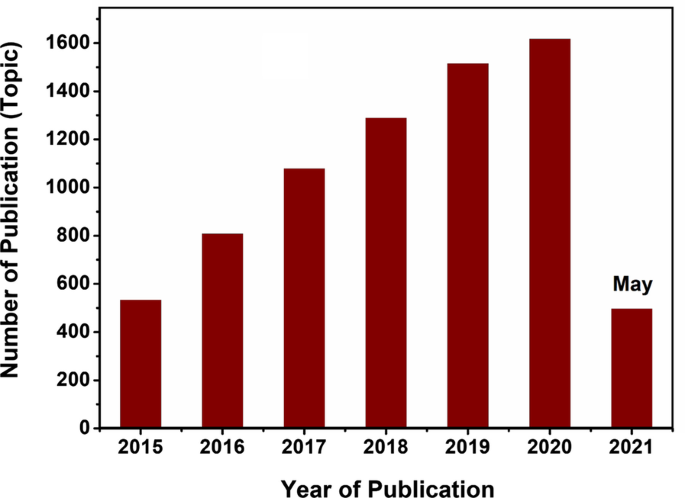
“二维半导体”发表文章数量的动态变化 ” 基于 Web of Knowledge™
早期对二维半导体纳米材料特性的测量揭示了独特的电子特性,这与它们的微结构和块体对应物的特性无法相比。这些显着特征与源自二维材料的纳米级低维的量子限制效应有关 [26]。因此,这些独特的二维材料规格为研究其基础物理和化学提供了极好的平台。第一种广泛研究的二维纳米材料是层状 TMDCs (XY 2、其中X =Mo、Ti、W 和 Y =S、Se 和 Te) [27,28,29,30,31,32,33,34,35,36,37,38,39]。在这个阶段获得的结果已经证实二硫属化物半导体在二维和体电导率(σ 1/σ 2 ~ 10 2 –10 3 ) [40]。此外,一些单层二维材料,如二硫化钼 (MoS2),是直接带隙半导体 [41]。获得的二维 TMDC 的电子特性对下一代现代纳米和光电器件的进一步发展具有重要意义。这些发现和其他各向异性源于强的夹层 X –是 键合,这与层之间的弱 vdW 相互作用形成对比 [42]。例如,TiS2 以六边形层状结构结晶,其中一个六边形堆积的 Ti 原子片夹在每个单层的两个六边形硫片之间 [43]。这种特定的原子分层结构使分层 2D 纳米结构的 vdW 分层成为可能。因此,早期的大多数报告都集中在通过机械和 vdW 剥离技术合成的 2D 材料的特性上。由于 2D 薄膜的超薄特性,它们可以透明、轻便和灵活,并且还具有非常有趣的特性。这些独特的特性为开发具有能量存储和转换应用的高性能电极材料铺平了道路,如电池、超级电容器和燃料电池 [44]。例如,图 2 总结了二维半导体和异质结构的主要特性,这些特性在其典型应用中得到了利用。
<图片>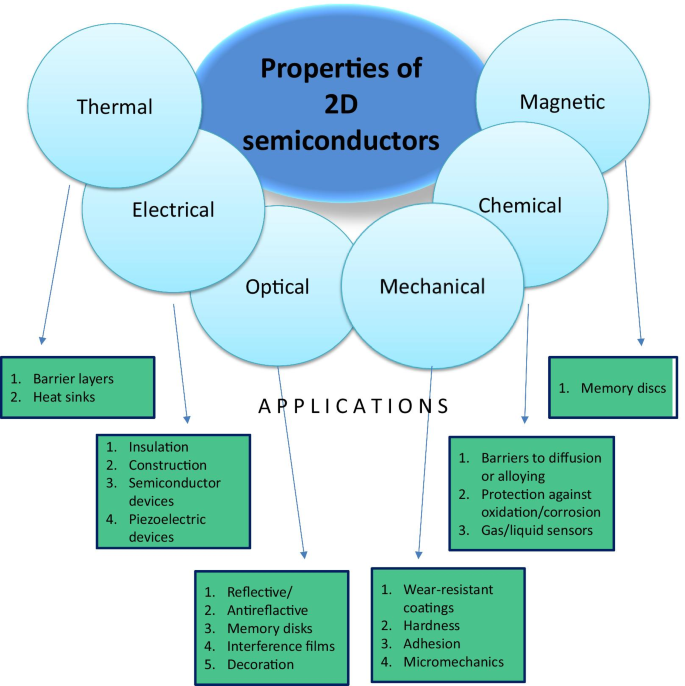
二维半导体在其典型应用中的特性
值得注意的是,由于纳米制造的最新技术进步,二维纳米结构半导体领域独立成为开发现代高性能纳米和光电仪器的重要知识 [45]。二维纳米材料的原子级层状结构是其卓越特性的起源,其中材料特性的精确可调性是由其尺寸的原子级控制提供的。因此,作为开发基于 2D 纳米材料的先进电子仪器制造方法的基本步骤,非常需要具有均匀厚度的超薄 2D 薄膜的共形合成。具体而言,为了在所需基板上生产具有精确且均匀厚度的晶圆级超薄膜,必须开发用于制造基于 2D 半导体的仪器的成功合成技术 [46]。此外,在合成和制造阶段,二维纳米材料可以被装饰,并且可以与电子单元的各种组件直接接触,包括电导体、绝缘体和具有各种几何特征的基板。还应该考虑到二维纳米材料和其他组件之间的异质界面会从根本上影响它们的性能。这尤其与 2D 层之间的电荷转移机制有关 [47]。异质结构 2D 薄膜的独特特性使其可用于许多应用,包括异质结构电子学、光电子学、生物传感、环境传感器、催化、可穿戴和柔性电子学、忆阻器和突触装置 [36, 44, 48 ,49,50,51,52,53,54,55]。因此,合成和制造技术应该反过来响应基于二维纳米材料的功能仪器的制造复杂性。此外,二维材料的电子特性受材料特性的影响很大,包括物理和化学结构、尺寸、层数、形态、取向、结构相、掺杂缺陷、非晶性或结晶度以及结构中的晶界[56]。二维纳米结构中的层数对电子结构有额外的基本影响,然后二维材料的性质完全决定了基于二维薄膜的电子器件的最终性能[57]。
另一方面,二维材料的结晶度或非晶性也会改变其电子特性。由合成方法及其条件决定,二维纳米材料可以无缺陷 (单晶)或含有一些杂质水平或很少的晶界。因此,通过界面散射现象的电荷迁移率受到晶界数量的影响 [58]。虽然单晶结构具有最高的电荷迁移率和低界面散射,但非晶二维结构代表了最高的绝缘特性 [58]。大多数早期二维纳米材料的合成方法都是基于二维纳米结构的机械剥离。由于层状结构之间的 vdW 力较弱,因此可以有效地采用机械和化学剥离来提取层状 2D 纳米结构 [59]。因此,机械剥离导致高质量晶体 2D 结构与其主体材料分离。然而,机械剥离已经无法合成大规模的二维纳米薄膜。类似地,二维材料的液相剥离是另一种低成本、大规模生产二维材料的合适方法。然而,质量控制和尺寸均匀性是通过这种剥离技术合成二维薄膜的主要挑战[58]。相反,通过气相沉积技术直接生长二维薄膜被认为是制造具有精确尺寸控制的高质量晶圆级二维纳米薄膜的最可靠和适用的合成方法之一。例如,CVD 和 ALD 是两种主要的气相沉积技术,它们为纳米结构二维半导体及其异质结构的大面积制造提供了显着的技术优势 [60, 61]。通过分别在 CVD 和 ALD 工艺中仔细操纵生长参数,可以充分实现对厚度、化学成分、结晶度甚至掺杂元素和结构缺陷的百分比的精确控制。此外,除了传统的 2D 薄膜合成方法外,其他新型 2D 材料来源也在几年前出现。例如,液态金属的表面氧化物实际上是高质量天然二维纳米薄膜的独特来源,具有前所未有的特性,源于液态合金的物理和化学特性[61]。
因此,本综述将重点讨论 ALD 和 CVD 技术以及液态金属二维表面氧化物的 vdW 剥离,讨论二维纳米材料新型合成方法的最新发现。解释了气相沉积技术中二维材料的生长机制,并讨论了二维半导体材料制造和沉积的关键挑战和机遇。此外,介绍了最近开发的液态金属二维自然表面氧化膜的 vdW 剥离技术。最后,最先进的 详细介绍了基于超薄二维器件的功能应用,包括其电子和光电特性。
通过基于蒸汽的制造技术合成的二维纳米材料
二维半导体材料领域的主要研究重点是二维纳米结构的合成和后续表征。这些二维纳米结构属于范围广泛的无机、有机和聚合物材料,具有原子级和薄的厚度。综合策略通常遵循两种主要方法,即自顶向下 和自下而上 策略。因此,具有可控架构和物理和化学特性的二维半导体的开发在各种应用中起着关键作用,并将开辟新的可能性,其水平明显高于当今的商业半导体技术。尽管如此,尽管过去几年在二维半导体方面做出了巨大的努力和独特的科学发现,但其中大部分是在实验室中使用非常简单的剥离技术获得的,不能用于工业应用。一种选择代表自上而下 这种方法通常涉及分层材料和分层共价有机框架 (COF) 的分层和 vdW 剥离。然而,这种方法的瓶颈在于产品的极低产量和凝固过程中板材的重新堆叠。另一种选择是基于自下而上 无机、有机或聚合物前体以二维方式的各向异性组装。尽管在制造二维纳米材料方面取得了一些成功,但对在电化学能量存储和转换中具有各种功能的合理设计的二维纳米片的深入研究仍然很原始。因此,非常需要全面探索具有定制厚度、高表面积、良好导电性和机械灵活性的二维纳米材料的独特性,以加速各种应用中的离子扩散和电子传输。以下部分概述了二维材料的两种主要沉积技术,即 CVD 和 ALD 的基础,重点介绍了近年来的成就。
二维纳米结构的 CVD
基于气相的超薄膜直接生长是沉积具有超精密尺寸规格的高质量薄膜的最可靠和适用的合成方法之一 [62]。在各种方法中,CVD 代表了第一个众所周知的在几种不同基板上生长超薄 2D 薄膜的成功技术。 CVD 为高质量大面积二维薄膜的生长提供了一种可扩展和可控的方法 [63]。有几个不同的规范使 CVD 方法成为二维纳米材料可控沉积的可靠技术。该方法基于气态材料在基材表面上的逐步反应。 CVD 反应之后是具有很少原子层厚度的固态薄膜的生长。因此,二维纳米材料的性质高度依赖于界面性质、基材的几何特征和固体薄膜的结构相。这些特性可以通过精确调整 CVD 生长参数来仔细调节。要了解 CVD 生长的一般机制,应了解温度、压力、衬底和前驱体等 CVD 参数如何影响表面的传质、传热和界面反应。在这方面,必须开发一个设计良好的配方来控制过程中的主要沉积参数 [64]。此外,它能够控制二维纳米膜中的掺杂水平,这是设计具有特定特性的半导体纳米结构的重要能力 [64]。例如,可以在 CVD 过程中控制硫属元素和金属空位的水平。 CVD工艺的以下关键参数高度依赖于结构相、形貌和界面反应。
温度
温度是直接影响 CVD 薄膜生长过程中几个相互关联的因素的主要基本参数之一,包括前驱体的化学反应速率、载气流量,最后,影响 CVD 薄膜的生长速度 [64]。通常,较高的 CVD 温度可确保高质量 2D CVD 薄膜的沉积。然而,极高的温度也有缺点。具体来说,它会产生高浓度梯度,从而导致系统中的质量流量和传递不稳定[64]。它还直接影响腔室中的组件饱和压力,从而改变薄膜的生长速度。在二维 TMDC 薄膜的 CVD 沉积过程中可以观察到温度和压力的综合影响。在这种类型的二维纳米结构中,系统中硫和硒元素的浓度对于确定二维薄膜的最终成分非常重要。例如,高气压和高浓度使二维 TMDC(MoS2、WS2 等)的可控合成成为可能。通常,伴随有足够压力的高 CVD 温度有利于热力学激活沉积机制,而低 CVD 温度通常会导致动态生长过程 [64, 65]。可控生长机制最终导致二维TMDCs的可控生长,具有调节性能和多个基本层的能力。
压力
CVD 也称为可变压力沉积技术,其中工艺压力可以从大气压改变到几毫米。可控 CVD 工艺的最有利条件是在质量进料的低浓度和高速度下实现。在这方面,在 TMDC 2D 纳米结构的晶圆级沉积中,低压对于超薄 2D 纳米结构的均匀生长总是更可靠 [66, 67]。组分的分压也会直接影响二维 TMDCs 薄膜的均匀逐层生长。因此,通过 CVD 技术生长 2D MoS2 薄膜是最著名的例子之一,其中在初始生长的薄膜上制造第二基础层只能在低压下在第一沉积层的晶界处开始。
基材
衬底的性质对二维薄膜和异质结构的生长有根本的影响。例如,金属基材、Si、SiO2、云母和聚酰亚胺是二维薄膜 CVD 沉积最常用的基材之一 [68, 69]。衬底对二维薄膜生长机制的作用决定了它们的结晶度、晶粒取向、微观结构和性能。具体而言,沉积在金、镍、铜和银基材上的二维金属氧化物薄膜表现出催化活性[70,71,72]。通常,在金属基材的情况下,具有特定结晶方向的 2D 薄膜的优先生长在技术上取决于金属基材和沉积的 TDMC 薄膜之间的面相关结合能 [73]。它还直接影响生长的纳米结构的形态。如果二维金属氧化物沉积在 Au 膜上,Au 和氧 (O) 之间的键能以及二维氧化膜的 Au 和金属 (M) 组分决定了 Au 和金属氧化物膜之间异质界面处的化学键结构[73]。预测 Au 和氧化物膜的金属原子之间的优先键合,主要导致 Au-M-O 界面的形成 [74,75,76]。 Au 或其他金属基材与沉积的氧化物薄膜之间的强相互作用使二维氧化物能够从金属基材的晶体结构中自适应生长 [77,78,79]。这意味着第一金属氧化物单层的生长模式遵循金属衬底的晶体模式。例如,虽然 Au 具有面心立方 (fcc) 晶体结构,但其在 Au 衬底表面上的晶体方向决定了二维金属氧化物膜的晶体取向。值得注意的是,未构造的 Au (111) 由六边形晶格组成,而重建的 Au (111) 平面显示出复杂的结构 [80, 81]。观察到 Au 衬底上的各种沉积氧化膜提升了人字形重建,这是由 Au(111)面与超薄氧化膜之间的强相互作用引起的。在包括 TiOx 的 Au 衬底上生长了几种不同的二维金属氧化物 , VOx 、CoO、MoO3、MgO、ZnO 和 WOx [82]。著名的催化剂示例之一是在 Au (111) 基材表面上生长的 2D TiO2 [83]。有人提出,Ti 原子占据了 Au 晶格的三重空心位置,O 原子位于 Ti 原子的桥位,然后形成了具有 Ti2O3 化学计量的蜂窝结构,如图 3a 所示 [83]。此外,还有另一种二维氧化膜的生长机制,其中 M-O 晶格叠加在 Au (111) 表面上并形成 莫尔 图案导致具有 TiO 化学计量的风车结构的不同外观的生长,分别如图 3b 和 c 所示[83]。六角形莫尔 在Au(111)衬底上的TiO、FeO[84]、CoO[85]和ZnO[86]超薄膜的CVD过程中通常观察到图案生长。
<图片>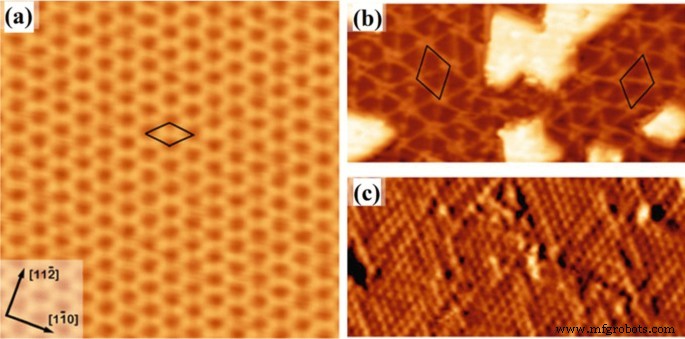
a 的 STM 图像 蜂窝状 Ti2O3 结构,以及 b 在 Au (111) 和 c 上生长的风车 TiO 单层 Au (111) 上风车结构的原子分辨 STM 图像。转载自[83]
MoS2 是二维 TMDCS 家族的典型代表。到目前为止,它被认为是所有 TMDCS 中最有利的纳米材料之一,因为它的块状材料和单层的带隙相对较小,分别为 1.29 eV 和 1.90 eV [40, 87, 88]。以前,单晶 MoS2 2D 薄膜仅从其主体主体上机械剥离。作为直接带隙半导体,单层 MoS2 为实现带间隧道场效应晶体管 (FET) 提供了有趣的可能性,其特点是开启比 60 mV dec−1 对于经典晶体管,因此功耗更小。在硅(一种间接带隙半导体)的情况下,这一特征仍然难以实现,因为那里的带间跃迁需要声子和复合中心 [87]。 2D MoS2 纳米晶体最近有趣的应用之一是基于单层 MoS2 纳米片的晶体管 [87] 和光电晶体管 [40]。此外,通过改进的 CVD 技术,包括金属有机化学气相沉积 (MOCVD)、低压化学气相沉积 (LPCVD)、电感耦合等离子体化学气相沉积 (ICP-CVD) 等,成功实现了二维薄膜的大面积沉积。 ),或由其他技术开发和组合的其他创新方法。 CVD 也因其在 2D TMDC 薄膜的晶圆级沉积能力而闻名。图 4 显示了一个有趣的例子是超薄 2D MoS2 和 WS2 薄膜在 4 英寸晶圆上的更大面积沉积 [88]。在该 CVD 工艺中,Mo(CO)6 和 W(CO)6 和 (C2H5)2S 用作 MOCVD 技术的前驱体,而 H2/Ar 用作 MOCVD 工艺中的载气(图 4a、b) [88]。结果表明,8100 个基于 2D MoS2 薄膜的高性能 FET 单元是通过使用光刻技术与相同的背栅基板制造的(图 4c)。在该单元的第二种配置中,外部 SiO2 介电膜沉积在 2D MoS2 膜上以制造 FET 仪器(图 4d)。晶体管的电气测量证实了 FET 的一致性能,这是从不同的晶片部件中挑选出来的。因此证实了二维MoS2和WS2薄膜在CVD过程中的均匀和保形生长条件(图4f)。
<图片>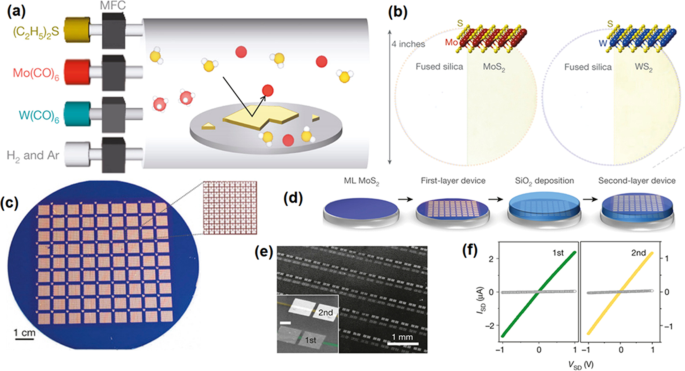
连续 MoS2 和 WS2 薄膜的晶圆级 MOCVD 生长。 一 二维 MoS2 和 WS2 薄膜的 CVD 设备和 MOCVD 相关前驱体的图形示意图。 c 批量 8100 个基于 Si/SiO2 晶片上的 2D MoS2 薄膜的 FET 器件。插图显示了包含 100 个设备的一平方毫米的放大图像。 d 堆叠式二硫化钼器件的顺序制造阶段。 e 该图像展示了第一层和第二层上的 MoS2 FET 器件。 f 两个不同层上的两个相邻 FET 器件的 IDS-VDS。转载自[88]
CVD 也已成为制造各种二维异质结构的通用技术 [89]。例如,CVD 被用于成功沉积横向和垂直配置。在横向结构中,二维纳米膜在原子水平上附着在一起,而在垂直结构中,层间的相互作用力具有 vdW 性质。因此,在横向二维异质结构中,严格的晶格匹配对于二维异质界面的发展非常必要,正如 MoS2/WS2 异质结构所报道的那样 [89]。当在 CVD 过程中使用硫、三氧化钼和钨前体时,建立了 MoS2/WS2 横向二维异质结构的一步简单沉积(图 5a、b)[89]。开发的二维薄膜具有尖锐的原子异质界面,其中原子平面与扶手椅和锯齿形取向共享相同的晶体取向(图 5c)。薄膜的最终形态是三角形核壳形状,里面是 MoS2,外面是 WS2(图 5d)。拉曼表征研究证实了垂直和横向二维薄膜的制造(图 5f)。开发p-n 二维 WS2 和 MoS2 薄膜之间的异质结增强了二维异质结构薄膜的光伏效应。因此检测到强烈的光致发光现象(图 5e,g)[89]。表征了与 WS2 和 MoS2 2D 薄膜具有相同晶体取向和晶格结构的相当尖锐的界面。此外,在另一份报告中,CVD 用于开发横向 1H MoS2/1T' MoTe2 异质界面,其中两个组件具有相对较大的晶格失配 [90]。还有其他几个案例,证明了具有大晶格失配的 2D TMDC 薄膜之间异质界面的发展,包括 2D WSe2/MoSe2 [91] 和 MoS2/WS2 [92],证实了 CVD 方法沉积半导体/半导体横向二维异质的能力-结构。因此,可以得出结论,现代 CVD 技术已经证明了其在有机和聚合物柔性基板、绝缘体和石墨烯基板上成功沉积二维材料的多功能能力。表 1 总结了 2D TMDCs 及其异质结构在晶圆级 CVD 技术制备的最新成果 [93]。
<图片>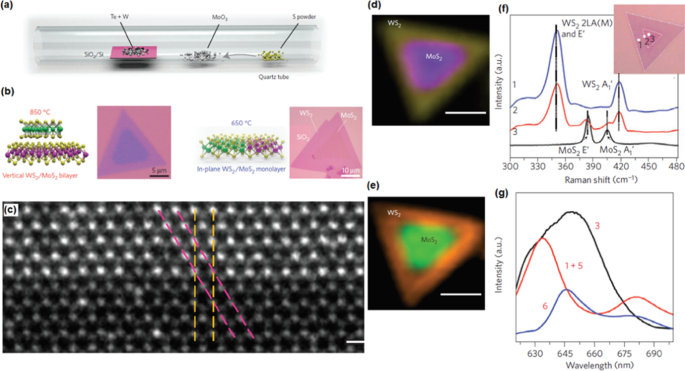
一 半导体/半导体横向二维异质结构的 CVD 生长示意图。 b WS2 和 MoS2 之间面内界面的原子分辨率对比 STEM 图像。 c 二维异质结构二维薄膜在 351 cm −1 处的拉曼强度映射 (黄色)和 381 cm −1 (紫色的)。 d 630 nm(橙色)和 680 nm(绿色)处的组合 PL 强度映射。转载自[89]
一般来说,尽管大多数已发表的作品中关于此类纳米结构长期稳定性的信息相当有限,但 CVD 制造的二维纳米材料和异质结构的稳定性相当高。考虑到纳米材料作为载流子散射中心,基于 CVD 生长的 TMDC 电子和光电仪器的长期性能和稳定性受纳米材料中的界面、缺陷和晶界的影响很大。这反过来又降低了器件的载流子迁移率。因此,制备具有清洁表面、高质量和晶圆级域尺寸的二维复合材料应该是未来纳米和光电子学的理想目标。还需要强调的是,大量其他二维复合材料还没有得到很好的研究或尚未成功生长,因此,更多令人兴奋的发现等待着我们去发现。
二维纳米结构的 ALD
ALD 作为 CVD 的一种改进,可以实施各种策略,以实现厚度控制制造二维半导体和夹层异质结构。虽然 ALD 最初是在大约 45 年前开发的,但直到 21 世纪初,由于其巨大的优势和各种前驱体的发展,它越来越受欢迎[94]。在过去的十年中,它已被用于制造多种类型的材料,包括氧化物、硫化物、硒化物、碲化物、氮化物和金属 [95]。一个关键要求是合适的分子前体必须经历自限反应,因为 ALD 和其他气相沉积方法之间的主要区别在于每次前体暴露后都会形成自饱和表面单层。在最近的评论中可以找到对 ALD 化学最新发展的完整描述 [94,95,96]。因此,到目前为止,ALD 已在多个领域实施,包括微电子 [97]、催化 [98]、光伏 [99] 和传感器 [100]。不幸的是,用于合成二维半导体和二维夹心纳米结构的原子层沉积实现相当有限。
作为沉积技术,ALD 由一系列自限性、表面饱和反应组成,以可控速率形成薄的保形薄膜。 Despite all obvious ALD advantages, it has to be admitted that this emerging technology has not yet been fully exploited for fabrication of different 2D nanostructures. Apparently, the lack of reliable recipes and precursors, specific ALD temperature window for deposition are some of the valid reasons for that. On the other hand, it was recently reported that the ALD advantages are far superior to the existing capabilities of other deposition techniques [101]. Specifically, ALD is the only one technology, which enables fabrication of defects-free, conformal 2D nanofilms and their heterostructures on the wafer scale with precise, Ångstrom scale control of their thickness during deposition [102]. In this regard, the state-of-the-art nanoscale ALD interfacing and molecular engineering of 2D nanomaterials can open up completely new possibilities by providing ultra-thin channels for key doping, minimization of the density of interfacial impurities and optimization of capabilities of instruments. Furthermore, the ALD fabrication technique enables turning the design of 2D nanostructures toward heterojunctions and hetero-structures [103,104,105], and hybrid SE based on inorganic–inorganic [106], organic–organic and inorganic–organic nanomaterials [107]. Figure 6 illustrates growing interests to ALD as well as comparison of the deposition rates and properties for 2D nanostructures developed by various deposition techniques [94].
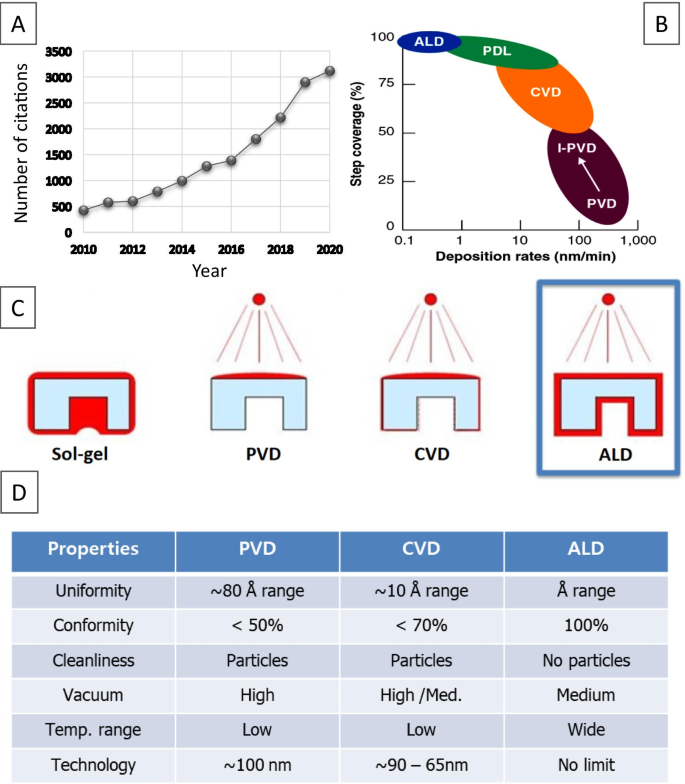
Number of annual citations on “Atomic layer deposition” topic a of published manuscripts. Data are according to Web of Knowledge™ Database. Comparison of the deposition rate vs step coverage (b ) and coverage areas produced by different deposition techniques (c )。 Comparative analysis of properties of SE fabricated by PVD, CVD, and ALD, respectively (d )。 Reproduced with permission from [94]
ALD of 2D Metal Chalcogenide Films
The layered TMDCs are composed of sandwiched structure where the metal layers covalently bonded with two individual surrounding chalcogen atoms, thus the layer-by-layer deposition mechanism in ALD technique is favourable for making layered 2D TMDC nanostructures. Among the different 2D TMDCs films including binary, ternary and doped chalcogenides, less than 20 type of them could be deposited via ALD method. The first MoS2 nanofilm was fabricated by ALD in 2015. Initially, the number of MoS2 layers was controlled by the tuning of parameters of ALD technique [106, 108,109,110]. Later, the ALD synthesis of TMDCs monolayer was reported [111,112,113,114]. The self-limiting layer synthesis (SLS) of MoS2 monolayer film was also facilitated based on the typical ALD half-reactions [115, 116]. Here, the some practical cases of ALD of stable 2D films of metal dichalcogenides are summarized in Table 2 [94].
The first investigation of 2D MoS2 deposition was based on the sulfurization of ALD deposited MoOx few-layered film. The formation of S–Mo-S arrangements of atoms along the z -axis was achieved after 10 min interaction of MoOx film with S gas at 600 °C [117]. The morphology, uniformity, crystallinity, nucleation and the quality of ALD-deposited film have direct impact on the final properties and characteristics of the MoS2 film [117,118,119,120,121]. In this example, the parameters of multistep annealing process should be controlled precisely to facilitate the formation of MoS2 films with sequential reduction of Mo and then incorporation of S atoms. In addition, the multistep reactions allowed the coverage control and phase transformation from crystalline MoS2 to the 2H-phase at the higher post-treatment temperatures. The first wafer-scale CVD of MoS2 on the 2-inch sapphire substrate was reported in 2014, when MoCl5 and H2S were employed as the precursors in the ALD system at 300 °C [121]. It was found that 10 sequential ALD cycles are required to establish the uniform growth of the MoS2 film and prevent the islands growth. The following post-annealing of ALD MoS2 film at 800 °C improved the crystallinity of MoS2 at the expense of losing the thickness uniformity of MoS2 on the wafer substrates. Thus, higher number of ALD cycles were done (20 cycles) to compensate the lack of uniformity due to the high-temperature post-annealing process. Considering the ALD window, it was found that the ALD process within 350 to 450 °C permits higher quality of sulfide layers with the growth rate of 0.87 Å/cycles [122]. It was also demonstrated that the following annealing of as-deposited MoS2 film in H2S or sulfur gas can improve the stoichiometry of 2D MoSx film [123].
The deposition of 2D MoS2 films via ALD technique can also be achieved by usage of other precursors. Other main precursors for deposition of MoS2 2D films were Mo(CO)6, H2S and dimethyl disulfide compounds. The ALD window suitable for these precursors is in the range of 155–170 °C. By monitoring the mass gain during the ALD cycles, it was revealed that multiple pulses of Mo source are required to reach the saturation, while a single H2S injection is sufficient to saturate the reaction and achieve the growth rate of 2.5 Å/cycle in the optimized condition [124]. The plasma-enhanced atomic layer deposition (PE-ALD) can also be successfully employed to deposit ultra-thin h -MoS2 film on the different substrates. The growth rate of 0.5 Å/cycle was observed at the ALD window of (175–200 °C) for deposition of 2D MoS2 films. Lower ALD window (60–120 °C) caused the deposition of amorphous 2D MoS2 films. Particularly, the ALD at 100 °C allowed the formation of continuous layer of amorphous MoS2 on the Si wafer. To improve the crystallinity of as-deposited ALD film, the later rapid thermal annealing (RTA) treatment at 900 °C led to the formation of crystalline hexagonal layer of MoS2 [125, 126]. Another recipe for deposition of 2D MoS2 film is Tetrakis (dimethylamido) molybdenum (Mo(NMe2)4), which interacts with either H2S or alternatively 1, 2 ethanedithiol (HS(CH2)2SH) to deposit 2D MoS2 films. In this recipe, the ALD of MoS2 film taken place at the lower temperature (T < 120 °C) since the Mo(NMe2)4 decomposes at temperature higher than 120 °C. The as-deposited 2D film was amorphous in this technique. Thus, the subsequent annealing was employed to crystalize the 2D MoS2 films. The mass spectroscopy analysis revealed that the mechanism of ALD deposition of MoS2 film is based on the removal of the remaining NMe2 ligands from the substrate surface after interaction of sulfur gas with Mo precursor. It was roved that it is possible to deposited 2D films on polymeric substrates by using lower ALD temperature.
2D WS2 is another example of the layered dichalcogenide ALD deposited at 300 °C by using WF6 and H2S as precursors [127]. A Zn-based catalyst is required to initiate the deposition of WS2 film via ALD technique. Diethylzinc (DEZ) and H2S were employed to assist the rapid nucleation of WS2 film over a wide range of substrates [128]. Zn acts as reducing agent for WF6 favouring the adsorption of WF6 on the surface of substrates. The initial growth rate of 1.0 Å/cycle was recorded, which then was reduced after 50 ALD cycles of WS2 deposition. It was found that the deposition of a monolayer ZnS film is also facilitated the growth of WS2 film with crystalline structure [129, 130]
WSe2 is another TMDC 2D film which was fabricated by ALD [124]. In this report, a self-limiting approach for WCl6 and diethyl selenide (DESe) at the higher ALD temperature of 600–800 °C was employed and the dependence of film thickness on the ALD processing temperature was observed [131]. Five, three and one crystalized layers of WSe2 were deposited on the Si/SiO2 wafers (8 cm 2 ) at 600 °C, 700 °C and 800 °C, respectively. After 100 ALD cycles, the growth of WSe2 was stopped due to growth saturation. The deposited WSe2 film with few layers and monolayer was crystallined with honeycomb structure. The same film was employed as a p -type semiconductor in the FET and showed the capability of ALD deposited WSe2 film for application in electronic devices. In another parallel attempt, the thermal ALD of continues WSe2 film on the Si/SiO2 substrate was successfully carried out at 390 °C [132]. WCl5 and H2Se were employed to deposit a highly uniform film with well-crystalline structure. The quality and crystallinity of the ALD WSe2 film were fairly compatible to the mechanically exfoliated and CVD WSe2 films [132].
SnSx 2D family is the other types of 2D materials which was extensively studied during last few years. The first deposited SnS film was reported by using tin (II) 2,4-pentanedionate (Sn(acac)2) precursor as the Sn source and H2S as the sulfur source, respectively, where the growth rate of 0.23 Å/cycle was achieved in the ALD window from 125 to 225 °C. The other precursors for ALD of SnS film are bis(N ,N ’-diisopropylacetamidinato) tin (II) (Sn(amd)2) and N2,N3-di-tert-butylbutane-2,3-diamine tin (II) which react with H2S gas during ALD [133]. This recipe enabled the deposition of crystalline SnS film at the ALD temperature of less than 200 °C.
2D SnS2 and SnSx films are deposited via employment of precursors containing Sn atoms [134]. The tetrakis (dimethylamino) tin (TDMASn) [135, 136] and tin acetate (Sn(OAc)4) [137] as the Sn (IV) metal precursors were used for ALD of SnS2 films. Polycrystalline hexagonal SnS2 films were deposited with the growth rate of 0.64–0.8 Å/cycle [134] at the temperature range of 140–150 °C. The growth of ALD temperature above 160 °C resulted in the development of thin mono-sulfide films. However, the as-deposited film always contains a combination of both mixed SnS and SnS2 compounds. Crystallinity of the film can still be improved by the following post-treatment annealing in H2S gas at 300 °C. As an example, the formation of a single phased orthorhombic 2D SnS2 films with interlayer spacing of 0.6 nm was reported after the post-annealing treatment at 300 °C in H2 atmosphere. Another precursor for ALD deposition of SnS2 film is Sn(OAc)4 where the ALD reaction in the ALD temperature of 150 °C resulted in the growth rate of 0.17 Å/cycle for the amorphous stoichiometric SnS2 film. Generally, in ALD deposition of few-layered SnSx films with Sn precursors and H2S gas, the chemical composition, structure and the stoichiometry of SnSx ALD structures can be modulated depending on the deposition conditions and the post-ALD treatments [137].
One of the main ALD capabilities is the wafer-scale deposition of 2D hetero-structured TMDCs, which opens up further opportunity for fabrication of vdW hetero-structures. The technological challenges for deposition of 2D hetero-structured films are the main concerns for their deposition. Basal plans of the most of 2D materials are inert with the lack of dangling band, thus the nucleation of 2nd family of 2D films over the first layer is considerably challenging. Therefore, it is necessary to enable the initial adsorption of precursors on the surface of 2D film and then facilitate the growth of second 2D film over substrate. One of such examples is the ALD deposition of Sb2Te3 film on the surface of graphene by using SbCl3 and (Me3Si)2Te as precursors [138]. In this ALD process, (Me3Si)2Te was initially physically adsorbed on the graphene. The successful low deposition temperature of 70 °C for ~24.0-nm-thick crystalline Sb2Te3 layer was finally achieved with the crystalline plane parallel to the graphene substrates. A sharp hetero-interface was formed between the graphene and Sb2Te3 film as depicted on the high resolution transmission electron microscope (HRTEM) image in Fig. 7a [138].
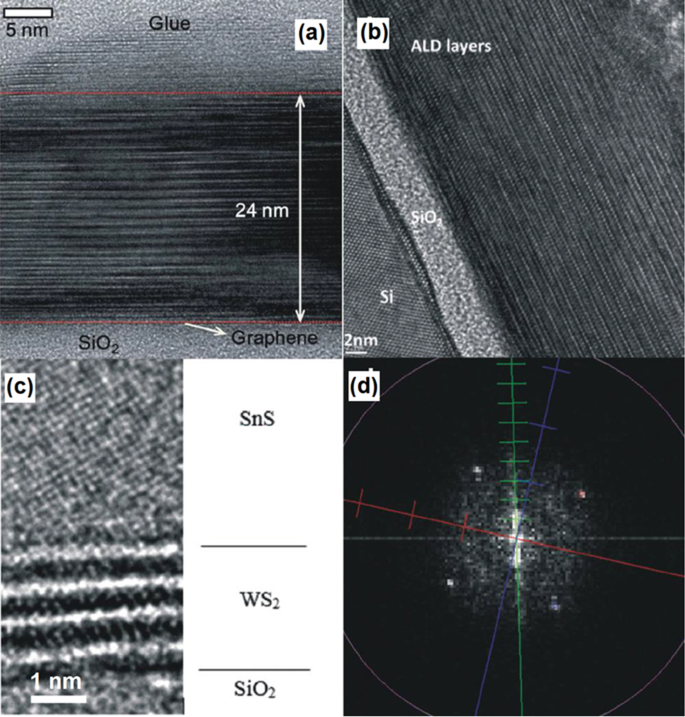
一 Cross-sectional image from the interface between ALD grown Sb2Te3 on graphene/SiO2 substrate. b The cross-sectional image of heterostructured Sb2Te3/Bi2Te3 stacked layers. c The HRTEM image of SnS/WS2 heterointerfaces and d the corresponding fast Fourier transform (FFT) image. Reproduced with permission from [138]
In another attempt, 2D hetero-structured Sb2Te3/Bi2Te3 metal chalcogenides films were deposited by the ALD process on Si/SiO2 wafer. Here, the bismuth telluride was selected to be deposited over the silicon wafer by the ALD technique at 165–170 °C, since it covers the Si better than Sb2Te3. Considering the low ALD temperature of Bi2Te3 (at 65–70 °C), the employment of initial long SbCl3 pulse in the ALD chamber was taken as a capable strategy to saturate the surface of Bi2Te3 and complete the surface reactions for the next deposition step [139]. This approach also facilitated the disposition of three stacking layers of Bi2Te3/Sb2Te3 with a high level of crystallinity. Another example is the growth of multiple WS2/SnS layered semiconductor hetero-junctions on the Si/SiO2 substrates by alternating ALD of WS2 and SnS at the ALD temperature of 390 °C [140]. The stacked 2D WS2/SnS has the 15° orientation angle between their c axis originated from the difference in crystalline structures and the lattice mismatch between WS2 and SnS (Fig. 7b, c) [133]. This misaligned crystalline characteristics of WS2/SnS hetero-interfaces is the origin of noticeable decreased of the holes mobility in SnS film [140]. Generally, the ALD techniques are recently undergoing consistent progress to enable the deposition of higher numbers of 2D TMDC films. However, there are still countless research opportunities to develop suitable ALD recipes for deposition of 2D TMDC films over the different substrates and also to develop nanoelectronic instruments based on 2D TMDCs.
ALD of Ultrathin Oxide Films
The few-nanometer-thick metal oxide films can be considered as 2D nanostructures when they can be assigned to few layers of 2D films. In this context, the characterization and exploration of 2D oxides properties for the practical applications are considered as valuable technical knowledge along with the progressive advancement in the device miniaturization. Furthermore, modern technologies use the advantages of ultra-thin metal oxide nanostructures as the main components of state-of-the-art nanodevices. Consequently, promising applications for the ultra-thin 2D semiconductors and insulators are expected, such as solid oxide fuel cells, catalyst films, corrosion protection layers, chemical sensors, spintronic devices, and UV and visible light sensors. Metal oxide semiconductor field-effect transistors (MOSFET) and the other novel nanoelectronic instruments are fundamentally dependent on the ultra-thin uniform films of metal oxides. Complementary, metal oxide semiconductor (CMOS) sensors are technically developed based on the deposition of ultra-thin metal oxide films which opened up a quite number of the different applications from image and light sensors to FET transistors in low-energy semiconductor instruments. The solar energy cells, plasmonic devices, data storage applications, bio-compatibility and bio-sensing features, supercapacitance properties, and electrochemical sensing are among the recently announced and discovered applications of the 2D oxide semiconductors. Thus ALD deposition of 2D metal oxide semiconductor thin films is considered as advanced fabrication technology. It is also an extremely difficult target to achieve considering the fact that the structural stability and molecular integrity of 2D films can be deteriorated easily. Accordingly, one of the main challenges is the versatile and conformal deposition of these 2D oxide nanostructures on the convenient substrates [94]. The following section is specifically focused on the ALD of metal oxide materials, and particular attention is given to molybdenum, titanium, aluminum, and tungsten oxide 2D films.
MoO3
Distinguishable properties of nanostructured molybdenum trioxide (MoO3) made it an excellent candidate for catalytic, electrical and optical applications. There are also several promising functionalities originated from the heterointerface between the MoO3 semiconductor and their metallic substrates. The bis(tert-butylimido) bis(dimethylamido) molybdenum ((tBuN)2(NMe2)2Mo) is one of the precursors for MoO3 deposition, since it provides good volatility and thermal stability [141]. The PEALD window for molybdenum oxide with O2 plasma and ((tBuN)2(NMe2)2Mo) precursor is in the range of 50–350 °C. The as-deposited films fabricated at the temperatures below 250 °C are usually amorphous, thus the post-deposition annealing process is needed to experience a transition from the amorphous to crystalline state. While the as-deposited films are sub-stoichiometric, the stoichiometry can be adjusted by the modulation of plasma parameters. The other precursors for ALD of ultra-thin MoO3 film is Mo(CO)6 which is mostly employed via O2 plasma to facilitate the low-temperature PE-ALD of MoO3 films in the narrow ALD window of 152–172 °C [141]. The resulted MoO3 film was deposited with growth rate of 0.75 Å/cycle. The as-deposited film was found amorphous with the oxygen deficiency at the heterointerface between substrate and MoO3 film. To achieve the crystalline structure, the following post-annealing at temperature above 500–600 °C is required. In another strategy, the ozone plasma was used on the surface of ALD MoO3 film deposited on 300 mm Si/SiO2 wafer [141]. Mo film was fabricated by using Si2H6 and MoF6 precursors at 200 °C. The wafer-scale deposition of ultra-thin MoO3 film over 4-inch Au on the Si/SiO2 wafer was reported, where C12H30N4Mo as molybdenum precursor and O2 plasma as oxygen source were used at two ALD temperatures of 150 and 250 °C, respectively. The process includes the pre-exposure of bare Au surface by O2 plasma which assists the formation of OH bonding on the Au surface. The following chemisorption of C12H30N4Mo molecules by the active sites on the Au and interaction with OH group on the surface of Au film led to the ligand exchange. The following O2 plasma completed the oxidation process and finalized the growth of ultra-thin monolayer MoO3 film (Fig. 8). The development of Mo–O-Mo bonding is expected after completion of oxidation process. Finally, 4.6-nm-thick MoO3 film was deposited over the wafer substrate. In this technique, the growth rate from 0.78 Å/cycle to 1.21 Å/cycle was measured when the ALD temperature increased from 150 to 250 °C [141].
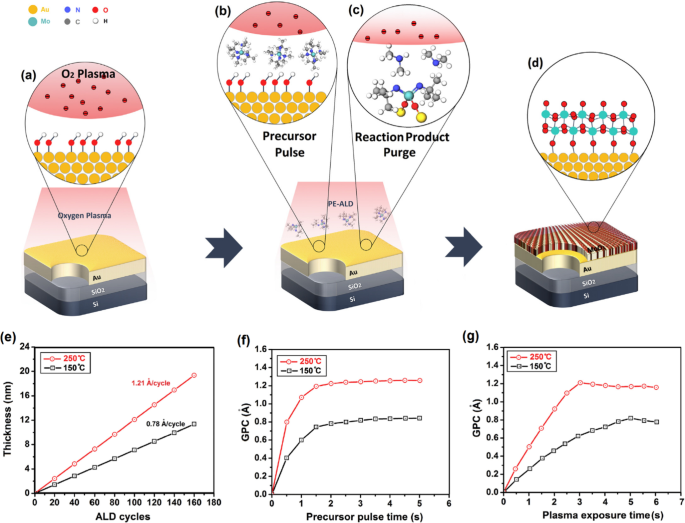
一 Graphical scheme of deposition of 2D MoO3 nanofilms by PE-ALD. b The injection of precursor into ALD chamber and c the reaction between precursor and Au surface (d ) and the complete deposition of a monolayer film over Au substrate. e The thickness of PE-ALD MoO3 film over Au substrate vs. the ALD cycle number at based on the usage of (NtBu)2(NMe2)2Mo precursor and O2 plasma at 150 °C and 250 °C, with the precursor dosing time of 2 s and plasma exposure time of 5 s. f The saturation curve of (NtBu)2(NMe2)2Mo precursor. The GPC is demonstrated as the function of precursor dosing time. g The saturation curve for O2 plasma showing the GPC as the function of plasma exposure time. Reproduced with permission from [141]
WO3
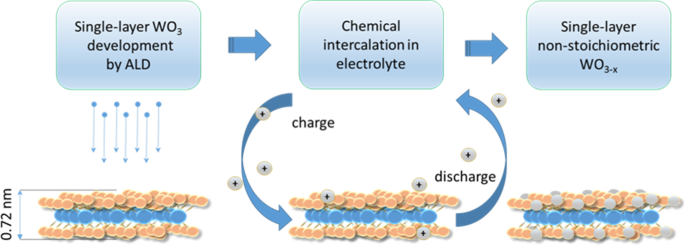
Enhancement of non-stoichiometry in monolayer WO3 film developed by ALD via intercalation/de-intercalation process
TiO2
Wafer-scale deposition of ultra-thin titanium dioxide (TiO2) film on the Si/SiO2 substrate was achieved by using the using tetrakis (dimethylamino) titanium (TDMAT) precursor and H2O as an oxidation agent [145]. The optimum ALD temperature of 250 °C was selected for ALD of monolayer TiO2 film on the wafer-scaled substrate. To achieve a complete coverage of monolayer TiO2, two individual ALD super-cycles were designed and implemented [145]. The first super-cycle consisted of 10 consecutive cycles of pulse/purge TDMAT to assure the reliable coverage of surface by precursors. Afterward, 10 pulse/purge stages of H2O were performed to assure the completion of oxidation [145]. The XPS studies confirmed the changes of binding energies in both Si 2p and Ti 2p peaks after the deposition of 2D TiO2 could be elucidated by the development of Si–O–Ti bonds at the interface between native SiO2 and deposited 2D TiO2 film. The deposition of TiO2 on SiO2 substrate was accompanied by the decrease in binding energy of Si 4+ which was related to this fact that the silicon was more electronegative than titanium. The evidence of oxygen bridge bonding was also demonstrated by characterization of vibrational mode of Ti–O–Ti bonds in the FTIR spectrum of monolayer TiO2 and also by investigation of XPS spectrum of monolayer film [145]. The bandgap of 3.37 eV was measured for this TiO2 film with atomic-scale thickness. The capability of ALD for deposition of ultra-thin films is of great importance to functional applications like microelectronics and catalysis where only few ALD cycles are desirable. Table 3 summarizes practical cases for ALD development of various 2D metal oxides reported to date.
In regard to stability of the ALD fabricated 2D nanostructures and their heterointerfaces, its mainly depends on the surface chemistry of ALD of 2D materials, especially because the inertness of their basal plans is expected to inhibit their growth and thus formation of vdW heterostructures. Moreover, as each precursor has specific “ALD window ” of deposition temperatures, trials and errors approach is required for optimization of the ALD fabrication temperature for each specific precursor taking into account the final thickness and porosity of deposited materials [98, 109]. Owing to the low deposition temperature, ALD of 2D oxides usually leads to fabrication of amorphous layers [32, 94]. Hence, when the crystalline phases of metal oxides are needed, post-annealing treatment is generally applied, improving the crystalline quality of the films as well as the interfaces with the substrate, which ultimately leads to the better stability of 2D nanomaterials over the time. Finally, although ALD appears to be a method of choice to fabricate oxide monolayers due to its precise control of the film thickness, only a handful of reports can be found in the literature [21, 32, 98, 141, 144, 145]. Therefore, the area of 2D metal oxide and their hetero-interfaces fabricated by ALD remains rather unexplored.
Self-limiting 2D Surface Oxides of Liquid Metals
The library of novel 2D materials for advanced applications is currently limited by the conventional synthesis methods of 2D films. The mechanical exfoliation of 2D films from their host layered bulks is not technologically precise and attractive method since the sizes distribution and thickness of produced nanosheets are not adequately and accurately controlled [146]. While the high vacuum techniques are accuracy of the depositing films are considered as high-quality films, these methods are still expensive, time consuming, and restricted by availability of precursors [64]. On the other hand, it is always desirable to introduce new synthesis methods of 2D materials in order to obtain the advanced 2D nanostructures with superior properties. Thus, synthesis of novel 2D semiconductor materials with distinguished or improved characteristics still remains a fundamental challenge.
Room-temperature liquid metals are a group of metals and alloys with unique electron-rich metallic cores which let them to stay in the liquid states even at the room temperatures. The interface of liquid metals with surrounding environment is the origin of one of the most natural 2D films [147]. This self-limiting surface oxide films (skin) is one of the most perfect planar materials with atomic scale thickness [148]. These crystalline structures are the host of unique properties and have provided a novel platform for synthesis of high-quality thin-film 2D materials for advanced applications [149]. Here, the liquid metals have the role of host material for synthesis of 2D films. With respect to the atomic structure, elemental composition, fluidity and thermodynamic of liquid metals, and furthermore, by considering the nucleation and growth characteristics of the surface oxide films, countless parameters are engaged to determine the proprieties of extracted 2D surface oxide films [150]. The low melting monophasic metal alloys are composed of post transition metals (Ga, In, Sn, Pb, Al, and Bi) and the elements of group 12 (Zn, Cd, and Hg). These elements can be combined together to produce a group of liquid alloys with low melting temperature. A biphasic liquid metal (mixture of solid and liquid) can be formed by either deviation of alloy composition from eutectic point or via adding solute elements above the solubility limit into the liquid metal solvent [151]. Gallium (Ga) is one of the most famous liquid metals with room-temperature melting point and possessing both covalent and metallic bonds at the solid state. The strong structural anisotropy and weak atomic bonding between Ga dimmers is originated from the distance between Ga neighbour atoms 2.7–2.9 Å which is considered as a significant distance between the gallium dimers [152]. This weak atomic bonding results in the weak crystalline structure in gallium which can easily break up at the room temperatures [153]. The alloying of Ga with some of the other elements may lead to further decrease in melting temperature of liquid alloy. One of the famous examples is the Ga-In alloy, when the melting temperature decrease to 16 °C in eutectic point of In-Ga alloy with atomic concentration of 14.2% indium [153]. The interface between gallium alloy and surrounding atmosphere is composed of the atomic-scale-thick gallium oxide (Ga2O3). The liquid metal reacts with atmospheric oxygen even at very low oxygen pressure forming a self-limiting metal oxidation reaction [153]. This ultra-planar oxide films are among the most perfect naturally grown 2D materials [61]. This natural film prevents the liquid metal from the further oxidation. The ionic transfer through the natural surface oxide film is the controlling factor for the natural growth of surface oxide films of liquid metal and alloys. The formation of this oxide film leads to the highest reduction in the Gibbs free energy (ΔG f) [154]. In a liquid metal alloy, the surface oxide film is mostly composed of surface oxide films of one of elemental oxide films of alloy components. The most famous example is the surface of oxide film of galinstan alloy. Galinstan (EGa, In, Sn) is the eutectic alloy of gallium–indium–tin. However, the surface oxide of galinstan is composed of Ga2O3. Since the ΔG f of Ga2O3 is lower than that of In2O3 and SnO2 in oxygen atmosphere, the surface oxide of galinstan alloy is mostly composed of Ga2O3 [155]. With the same synthesis strategy, it is possible to synthesize the mixed 2D oxide films similar indium–tin–oxide. To this aim, the molten In–Sn alloy should be used to extract 2D films from the surface of liquid In–Sn alloy [154].
Due to the nonpolar properties of liquid metals, the attraction force between the liquid metal and its natural surface oxide film is weak and localized. Thus, a weak mechanical force can simply delaminate the surface oxide films from the surface of liquid metals. The delamination of surface oxide film can be achieved via the mechanical separation and exfoliation of 2D films by applying mechanical exfoliation methods including sonication, touching of liquid metal with the appropriated selected substrate, mechanical rolling of the liquid metal and alloy over the smooth substrate and separation and extraction of 2D films through the density differences and gradients between the synthesized compounds. These methods were employed recently for delamination of several different types of the surface oxide films of liquid metals from their host alloy. The following section will review some of lately synthesized 2D surface oxide films of liquid metals and alloys.
SnO x
2D SnOx film was successfully delaminated via vdW exfoliation of the liquid tin surface oxide film. Elemental tin (Sn) with its low melting point (231.9 °C) [156] and its high conductivity (9.17 × 10 6 σ) is used as electrical connections in the electronic utensils. The anti-corrosion impact of tin oxide layer has been confirmed before. SnO2 naturally covers the surface of tin alloy under the atmospheric condition and prevents further oxidation of Sn [156]. It was found that the natural surface oxide film of liquid tin in the ambient atmosphere is composed of a mixture of tin oxides which is predominantly composed of SnO2, with some contributions of SnO, Sn2O3 and Sn3O4 [156]. The precise control of oxygen exposure to the surface of fresh molten tin is the main technical factor to determine the composition of surface oxide film of tin alloy. This is a highly important factor during the synthesis of the surface oxide film of molten tin, when we take into consideration the fact that the SnO2 is n- type semiconductor, and SnO is a p -type semiconductor with a variety of different electrical properties. The bipolar characteristics of SnO is another important properties of this material which made it a functional choice for application in electrical invertors [157]. Furthermore, the high stability and sensitivity of well-established SnO films turned them to the desired option for application in chemical-based FET sensors and catalyst films. The transparency is another characteristic of SnO films originated from the wide bandgap of this semiconductor [156, 157].
To exfoliate2D SnOx film, the fresh surface oxide film of molten tin was mechanically delaminated by the contact of surface of Si/SiO2 substrate with the surface of molten alloy inside of the glove box [158]. The scheme of process was graphically demonstrated in Fig. 10a [158]. The delaminated SnOx film in ambient atmosphere had ~ 0.6 nm thickness [157] with crystalline structure. Considering the interlayer spacing of crystalline SnO (0.484 nm), 0.6-nm thick film can be considered as a monolayer SnO film and 1.1-nm-thick film is therefore a bilayer SnO 2D film (Fig. 10b). The 2D films synthesized in glovebox and under oxygen concentration of 10–100 ppm had ultra-fine surface characteristics. The measurement of interlayer spacing showed that the nanosheets formed under ambient atmosphere were composed of two distinct materials with interlayer spacing of 2.7 Å and the other 3.35 Å, which were respectively attributed to the crystal lattice of SnO and SnO2. The 2.7 Å lattice spacing was related to the (110) plane of SnO, while the 3.35 Å lattice spacing was attributed to the (110) plane of SnO2, respectively (Fig. 10c–e) [158]. The sample synthesized in the reductive atmospheres was mostly covered by SnO film. The bandgap measurement of SnO film showed the direct bandgap of 4.25 eV. This ultra-thin 2D film was employed to fabricate the SnO-based FET transistor. p -type characteristics of SnO-based developed FET was confirmed with the mobility of 0.7 cm 2 V −1 s −1 (Fig. 10g) which was much higher than the similar FET devices based on the pulsed layer deposited bilayer SnO film with the mobility of 0.05 cm 2 V −1 s −1 [159].
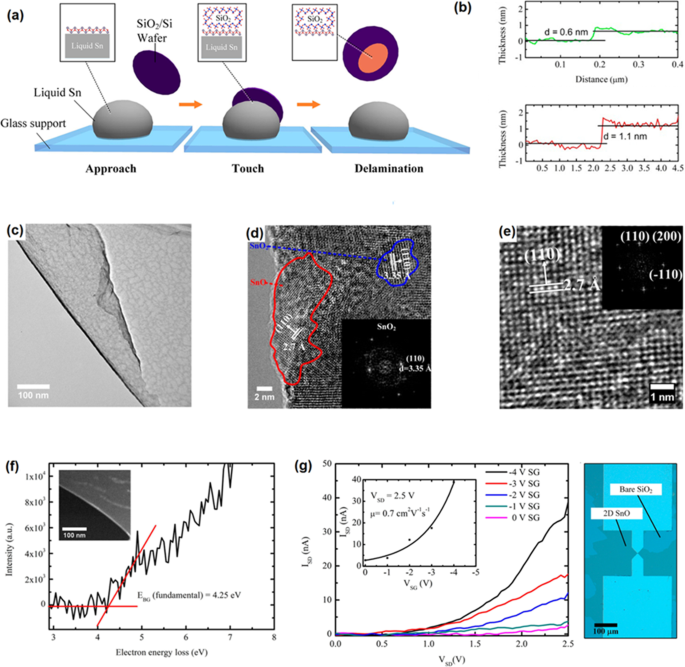
一 Graphical representation of vdW exfoliation method. When a Si/SiO2 substrate is attached to the molten tin alloy, the created vdW force between the tin oxide and SiO2 surface help to delamination and following attachment of 2D oxide film to the SiO2 substrate. b The AFM image of the monolayer (0.6 nm) and bilayer (1.2 nm) tin oxide film. c The TEM image of tin oxide film developed in controlled atmosphere. d The HRTEM of tin oxide film developed in ambient atmosphere with mixed SnO and SnO2 structure. e The HRTEM image of SnO film developed in controlled atmosphere. f The bandgap of monolayer SnO film measured by electron energy loss spectroscopy. g The I-V characteristics of fabricated SnO FET device at various gate voltages. Reprinted with permission from [156]
GaPO 4
The high-temperature stable gallium phosphate (GaPO4) semiconductor (up to 930 °C) is one of the functional piezoelectric semiconductors with outstanding technical position compared its rival of α-quartz [61]. Gallium phosphate has trigonal structure with the cell parameters of a = 4.87 Å and c = 11.05 Å and γ = 120° (Fig. 11a) [160]. The piezoelectricity facilitates the mutual conversion of electrical energy or pulses to mechanical forces or oscillations. To develop miniature power and electric instruments and generators, it is highly required to synthesize 2D piezoelectric materials for novel nanoelectronic technology. In this device, the atomistic level vibration, bending and displacement can be monitored and then facilitate the harvesting of kinetic energies of oscillation of piezoelectric materials. The loss of centro-symmetry is the main structural specifications of 2D materials with piezoelectric properties [160]. Many types of 2D materials including, TMDCs with odd number of layers, transition metal oxides, aluminium nitride, GeS and SnSe2, h -BN and graphene are capable of showing the piezoelectric properties [161,162,163] at the low temperatures. Nowadays, it is highly required to synthesize new 2D materials with stable piezoelectric performance at high operational temperatures. This is very challenging issue since the performances of 2D piezoelectric materials are failed due to the structural changes at the high working temperatures. Another difficulty arises from the challenging deposition stage of homogeneous 2D piezoelectric films of functional instruments.
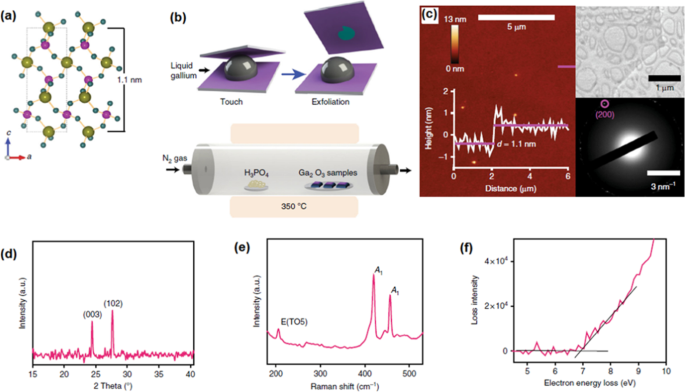
一 The side view of GaPO4 demonstrating the out-of-plane structure of GaPO4. b For the secondary phosphatization treatment. c The AFM and HRTEM studies of 2D GaPO4 film. d The XRD, e Raman and f bandgap measurement of 2D GaPO4 film. Reprinted with permission from [160]
As a successful achievement, the 2D archetypal piezoelectric GaPO4 film was recently synthesized via processing of 2D surface oxide film of gallium. The archetypal piezoelectric GaPO4 is not naturally available in crystalline scarified structure [160], and thus the conventional mechanical exfoliation techniques are not capable of synthesis of 2D crystalline gallium phosphate films. In this method, natural surface oxide film of gallium was mechanically exfoliated from its liquid alloy via vdW delamination technique, see Fig. 11b. The secondary post-annealing treatment was employed inside a furnace for the secondary phosphatiation treatment [61]. The vapor gas containing phosphor chemically interacted with the surface of 2D Ga2O3 film by the heating of H3PO4 powders. The N2 gas had the role of carrier gas for transfer of vapor phosphor gas to the surface of 2D Ga2O3 film at 300–350 °C (Fig. 11b). The following AFM and HRTEM measurement of samples confirmed the synthesis of 1.1-nm-thick 2D film with dimensional characteristics similar to the trigonal GaPO4 in the c crystalline direction (Fig. 11c) [160]. The XRD studies and Raman characterization have confirmed that 2D GaPO4 film had crystalline structured with dominance of (003) and (102) planes of trigonal α-GaPO4. (Fig. 11d, e). A wide bandgap of 6.9 eV was measured for α-GaPO4 film (Fig. 11f). The experimental measurements reaffirmed the strong out-of-the-plane piezoelectric properties for the GaPO3 2D nanostructures which was around 8.5 pm V −1 [160]。 This considerable piezoelectric characteristics of 2D α-GaPO4 highlighted the capability of this synthesis method to develop novel 2D materials with distinguishable mechano-electric properties.
GaN
The same post-processing approach was employed to synthesize GaN and InN 2D films from the surface oxide film of liquid gallium and indium [160]. The technique is based on squeeze printing of liquid gallium droplet between the Si/SiO2 parallel substrates (Fig. 12a). In contact with atmosphere, Ga liquid was instantaneously oxidized in atmospheric condition. The synthesis process resulted in the formation of 2D Ga2O3 films with thickness of 1.4 nm [157]. The following ammonolysis reaction at 800 °C was operated in the presence of urea. It was found that lower reaction temperatures did not facilitate the conversion of Ga2O3 into the wurtzite GaN films (Fig. 12b) [160]. The thickness of the film after ammonolysis process was found to be 1.3 nm which is corresponded to the to three wurtzite GaN unit cells (Fig. 12c). The lattice constant of 5.18 nm was measured for 2D GaN film. The TEM studies also confirmed the crystalline structure of GaN with interlayer spacing of 0.28 along the (001) crystalline plate (Fig. 12d) [160]. The X-ray photoelectron spectroscopy (XPS) affirmed the substantial amount of nitrogen was replaced by the oxygen atoms in GaN structure which is owing to the similar bond length of Ga-O and Ga-N. It was targeted to decrease the level of oxygen in 2D GaN films. However, the successful removal of oxygen from the 2D GaN films was not achieved even during the synthesis process at the high temperatures. A bandgap of E g = 3.5 eV was measured for 2D GaN film (Fig. 12e) compared with that of Ga2O3 film. The reason for the considerable decrease in the bandgap was attributed to the upward shift of the valence band of GaN film due to the hybridization of the O2p -N2p orbitals [160].
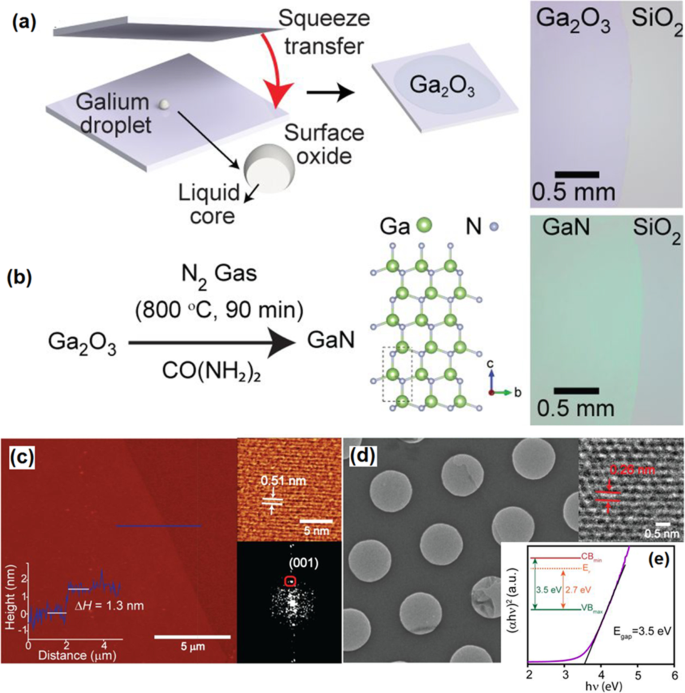
一 Schematic illustration of squeezing of liquid metal galinstan between SiO2 substrate and b following post-ammonolysis treatment for phase transform of Ga2O3 to GaN film. c The High resolution AFM image of the surface of GaN film. d The HRTEM image of GaN film and e the band gap of measurement of GaN film. Reprinted with permission from [160]
The similar strategy was used to synthesis 2D InN film via two-step synthesis technique [160]. In this method, the vdW exfoliated 2D In2O3 film was extracted from the surface of liquid indium. An intermediate bromination step was performed to transfer In2O3 to InBr3. A 20-s post-processing stage of In2O3 film adjacent to HBr source was enough to complete the phase transformation from In2O3 into InBr3 [61]. The following ammonolysis treatment of InBr3 2D film by NH3 source at the temperature of 630 °C resulted in the phase transformation of InBr3 into InN [160]. The following characterization studies confirmed the development of crystalline 2D ultra-thin wurtzite InN nanostructures with the crystalline lattice constant of 5.5 Å with the bandgap of 3.5 eV [160]. Generally, the multi-step synthesis technique was found as reliable approach towards the synthesis of advanced 2D nanostructures by using the surface oxide of liquid metals. The developed 2D nanostructures have clearly demonstrated novel electronic and optoelectronic characteristics which are not expected and observed in the similar 2D nanostructures, synthesized via high-vacuum deposition-based methods [164].
SnO/In 2 哦 3 2D Heterostructures
The p-n heterojunctions are now the building blocks of the semiconductor devices where the hetero-interfaces between two semiconductor materials with the different types of charge mobility properties are used to fabricate various types of electronic and opto-electronic instruments. Specifically, the heterostructured devices based on 2D films can be developed by several different approaches and techniques including mechanical exfoliation from the host material, CVD, ALD, molecular beam epitaxy, and pulsed laser deposition [165, 166]. Interesting new strategy was recently employed to fabricate vdW heterostructured 2D layered materials via stacking of various 2D layered crystals extracted from their liquid-based metals and alloys. A p-n heterojunction was developed by the vdW exfoliation of 2D SnO and In2O3 films [167]. In this method, 2D SnO/In2O3 vdW heterostructures developed [167] by the vdW transfer of surface oxide film of liquid tin (p -SnO) on top of the natural surface oxide of indium (n -In2O3). The developed 2D heterostructured film finally composed of p -SnO/n -In2O3 2D films attached on top of each other via vdW forces (Fig. 13a, b) [167]. The following microstructural studies in atomic scale levels confirmed the formation of a vdW heterointerfaces between SnO/In2O3 films with two crystalline structures with the different characteristics fabricated over Si/SiO2 substrate (Fig. 13c). The lattice spacing of 0.27 nm corresponded to the (321) plane of crystalline In2O3, and the other 2D film with 0.298 Å is attributed to the (101) plane of SnO. The heterostructured film had the thickness of 4.5 nm (Fig. 13d, e). The Raman and optical characterization studies confirmed the development of heterointerfaces with optical absorption peak of SnO/In2O3 film located at 251 nm, which was a number between 246 nm (SnO absorption peak) and 256 nm (In2O3 absorption peak in Fig. 13f, g) [167]. One of the main properties of heterostructured film was strong interlayer coupling of charge carriers which affected the optical absorption of 2D film. The bandgap of heterostructured film was narrowed to 2.30 eV while the bandgap of individual SnO and In2O3 were 4.8 eV and 3.65 eV, respectively, [167]. The schematic of band alignment at 2D SnO2/In2O3 vdW hetero-interfaces was demonstrated at Fig. 13h. The effective bandgap at p–n junction was expected to be 2.30 eV, which was close to the calculated value of band gap of 2D heterostructured film from Tauc plot. The narrow bandgap assisted the charge separation at hetero-interfaces, thus the photoexcited electron–holes can be separated easily and they can feasibly migrate from the valence band of SnO to the conduction band of In2O3 film. The specific energy band alignment at the hetero-interfaces of vdW SnO2/In2O3 demonstrated quite impressive capabilities and excellent photodetectivity of 5 × 10 9 J with the photocurrent ratio of 24 and the outstanding photoresponsivity of 1047 A/W [167]. Here, the liquid metal printing technique was found as the valuable potential approach for fabrication of heterostructured 2D materials, which do not naturally exist as the layered structures in nature.
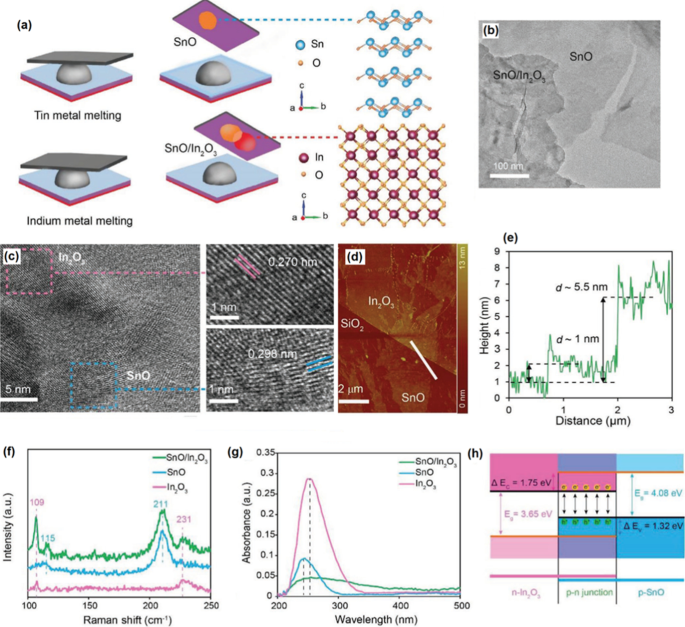
一 Schematic illustration of fabrication of 2D vdW heterostructured SnO/In2O3 film. b The HRTEM image of heterostructured SnO/In2O3 films. c The HRTEM image of atomic structure of heterostructured films show the high crystalline structure of SnO and In2O3 film with their lattice spacing distance. d The AFM of heterostructured SnO/In2O3 film with e the profile thickness of the films. f The Raman spectra of SnO, In2O3 and SnO/ In2O3 2D films. g The optical absorption of SnO, In2O3 and SnO/ In2O3 2D films. h The band alignment of SnO/ In2O3 2D heterostructures. Reprinted with permission from [167]
Therefore, the natural ultra-thin metal oxide films on the surface of liquid metals and alloys were found as functional materials with tremendous applications. Ultra-thin nature, pin-hole free and considerable lateral dimensions of these films accompanied by the facile vdW delamination of them on desired substrate provided a great platform for successful synthesize of novel generation of 2D materials and related electronic instruments [168]. Table 4 has provided a representative information on the recently developed 2D materials and devices based on 2D surface oxide film of the liquid metal and alloys.
Novel Applications of 2D Semiconductors
Memristors Based on 2D Semiconductors
The information technology today faces the fast growing of amount of generated data. The data processing in new era requires development of advanced data storage technologies far beyond of concept of current silicon-based technology. Today Si-based memories are facing their technological limits, furthermore, the complementary CMOS instruments are also suffering from the physical dimensional retractions and technological problems [169]. Consequently, it is highly required to develop new nanostructured materials with improved properties and also to modify the existing devices to circumvent the technological restrictions related to the storage capacity of memory units. The von Neumann technology tries to emulate the working mechanism of human brain where the complicated networks of interconnected biological synapse enable us to memorize, learn, remind, recognize, process and understand the multi-task operations with minimum energy consumption. An average power consumption for a singular synaptic event is in the range of 1–10 fj, which is at least 5 orders of magnitude lower than the energy consumption of the existing conventional computers [170]. The current von Neumann technology architecture is not efficient since their memory and processing units are physically separated. A low-energy consumption non-volatile memristors with nanoscale dimensions, high performance, and improved processing speed can respond the current memory technology which is in its bottle-neck stage [170]. Regarding the energy consumption issues, 2D materials can be employed as ultra-thin nanostructural memristors. The resistive switching (RS) behavior of 2D materials has also been explored recently. It was found that the employment of 2D materials in memory units could potentially tackle the current limitations in memory devices [171]. Recently, the nonvolatile characteristics of 2D materials have been extensively investigated and characterized. The 2D semiconductor layered materials and ultra-thin oxide films possess a wide range of properties in various fields which also can be accompanied by their memristive characteristics.
Memristors Based on TMDCs
The recent development in nanodevice fabrication technology enabled the employment of ultra-thin TMDC films in functional instruments. The CVD and metal organic CVD were successfully employed to deposit monolayer MoS2, MoSe2, WS2, and WSe2 2D films in a sandwiched in a vertical configuration between Au electrodes over Si/SiO2 substrate (Fig. 14) [172]. It was confirmed that monolayer TMDC films had no grain boundaries and they are empty of oxide compounds. Thus, an oxide free hetero-interface was shaped between Au electrodes and 2D TMDC films. This sharp and clean hetero-interface increased the possibility of precise measurement of electrical properties of 2D films. The graphical scheme of the memristor devices, the top view of device and the cross-sectional TEM image of Au/MoS2/Au memristor are presented in Fig. 14a–c, respectively. The characterization of 2D MoS2 by atomic resolution scanning tunnelling microscope (STM) (Fig. 14d) demonstrated relatively high quality and additionally showed local sulfur vacancy defects in the MoS2 film. The unit based on monolayer MoS2 film verified high on /off ratio above 10 4 and the corresponding retention time as high as 10 6 s。 The bipolar resistive switching was observed in the behavior of all memristors based on MOS2, MoSe2, WS2, and WSe2 2D films. Both unipolar and bipolar resistive switching behavior were detected during the study of resistive switching response of MoS2 films. The abrupt increase of the device current in all samples indicated the occurrence of dielectric break down phenomenon. The formation of conductive filaments (CFs) in the 2D active layer of memristors was the main mechanism of RS (Fig. 14e–i). Thus, the electroforming can be avoided by scaling down the thickness of active memristor layer into the few nanometer range. The main drawback of this strategy is the excessive leakage current originated from the trap-assisted device tunnelling [165]. Occasionally, the unipolar RS was observed in the certain single-layer MoS2 metal/insulator/metal units as was shown in Fig. 14 f. The typical bipolar RS behavior was also presented in the study of resistive behavior of atomristors based on monolayer MoSe2, WS2 and WSe2 films, respectively [172].
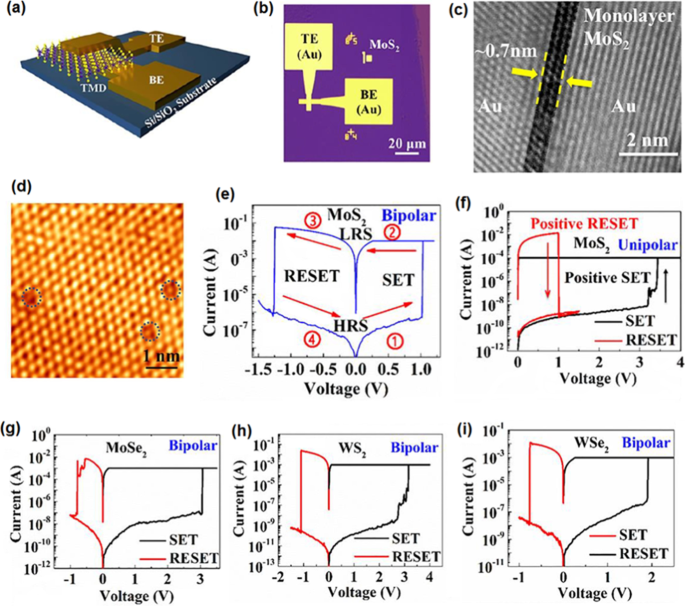
一 Schematic interpretation of metal/insulator/metal atomristor device based on TMDCs monolayers, b the corresponding optical image of device and the c cross-sectional TEM image of Au-Monolayer MoS2-Au device. d The atomically resolved STM image of monolayer MoS2 film deposited on Au electrode. The sulfur vacancies indicated by dashed lines. e The typical I-V curve of atomristor device based on monolayer MoS2 monolayer device. The typical bipolar RS behavior is observed. f The occasional unipolar RE behavior of device in monolayer MoS2 device. g , h and i graphs respectively demonstrate the typical bipolar RS behavior of atomristor devices based on monolayer MoSe2, WS2 and WSe2 films. Reprinted with permission from [172]
In another configuration, a memristor based on monolayer MoS2 was developed where a Cu electrode was employed as the active electrode to fabricate electrochemical metallization memory device [173]. In this instrument, the Au film play the role of inert conductive electrode. The scheme of this device is demonstrated in Fig. 15a. Due to the diffusion of Cu ions in MoS2 layer a conductive atomic-scale Cu filament is formed in the MoS2 double monolayer. Therefore, this memristor falls under the category of electrochemical metallization memories (ECM), whereas the memristive performance of other 2D MoS2 device with the inert electrode (similar Au) is based on migration of the sulfur vacancies. The sulfur vacancies in MoS2 thin films make conductive filaments with atomic scale dimensions, and hence these types of MoS2 memristors are known as the valence change memories (VCM) [173].
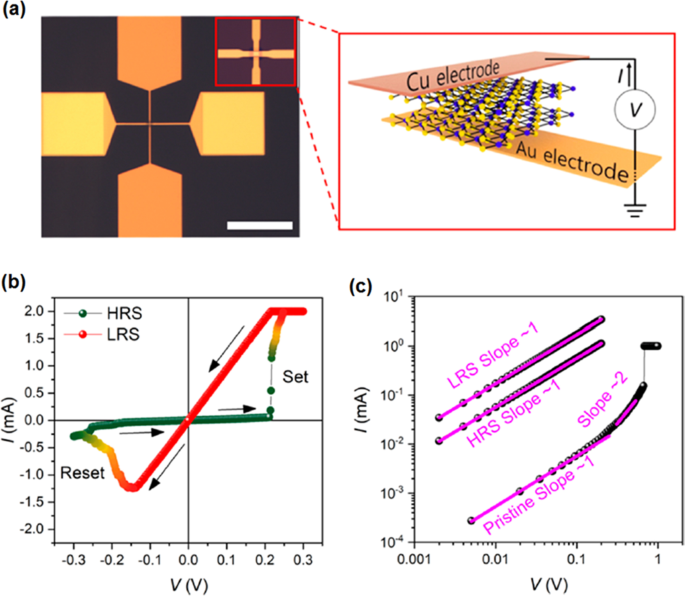
The optical image of Cu/MoS2 double layer/Au memristor device with scale bar of 100 μm accompanied by the graphical scheme of device with top Cu electrode and bottom Au electrode. The memristor’s crossbar area is 2 × 2 μm 2 . b The I-V curve of memristor device with bipolar RS with the 0.25 V Set voltage and − 0.15 V Reset voltage. e The logarithmic scale I –V curve of device for the pristine state before and after forming process, and for LRS and HRS after the forming process. Reprinted with permission from [173]
In fabricated ECM (Fig. 15), the two-dimensionality and electrochemical metallization by Cu cationic filaments resulted in the considerable decrease in switching voltage down to 0.2 V (Fig. 15b). This characteristic has arisen from the lower diffusion activation energy of Cu cations in MoS2 layer compared with that of sulfur vacancies in 2D MoS2 film [173]. The bipolar resistive switching was the main characteristics of the I-V curve of memristor with a set voltage at 0.25 V and a reset voltage at − 0.15 V. It was observed that the majority of double-layer MoS2 memristors are free of the forming process. By using a double-layer MoS2 memristor the transport mechanism in Cu/double layer MoS2/Ag device was investigated. Figure 15b depicts the I–V characteristics of memristor before the forming process (pristine state) as well as for HRS and LRS (after forming). The instrument performed in pristine state with the resistance of 16.6 kΩ when the applied voltage on the unit was less than 0.3 V. Quantum tunnelling was recognized as the conduction mechanism in memristor in the pristine state. In this condition, the resistance is much larger than the resistance of device after the forming process of memristor. The further increase of applied voltage beyond the 0.3 V in pristine state is accompanied by the transition in I–V curve into the slope 2 region (I ∝ V 2 ), which corresponds to the space-limited conduction states. The dramatic increase of current after increasing of applied voltage (further than 0.6 V) is attributed to the formation of Cu conductive filaments in MoS2 film (Fig. 15c). Higher imposed voltage on Cu electrode resulted in the oxidation of Cu top electrode. This resulted in the migration of Cu cations toward the bottom Au electrode to reduce and deposit there. The conductive Cu filaments were built up along the defective grain boundaries of 2D MoS2 film and the device switched to LRS.
Complementary Resistive Switching in Transition Metal Oxide Films
The ion doping of semiconductor films can tangibly alter the charge transfer mechanism in these ultra-thin films. The memristive characteristics of 2 semiconductors are also tangibly affected by the presence of other foreign ionic species inside active materials of memristors. TiO2 is one of the well-known recognized semiconductors with resistive switching characteristics. A 7.0-nm-thick TiO2 ALD film was used to investigate the impact of ion intercalation in resistive switching of this ultra-thin film [174]. To understand the effect of Indium (In) intercalation in active layer of memristor (TiO2), an ion incorporation set up was made. The ion intercalation in this set-up was facilitated by imposed driving voltage on the ion-containing solution covering the surface of 2D TiO2 film. The potentiodynamic measurements (I–V sweep) of Pt/TiO2/Au and Pt/In-doped TiO2/Au memristor under the dark condition showed different RS mechanisms for In-ion doped and non-doped TiO2 films. Pt/TiO2/Au device shows bipolar switching behavior (Fig. 16a). V Set = 0.94 and V Reset = − 0.98 during I–V sweeping measurement were observed [174]. A bipolar RS behavior of film was explained by the ionic drift of oxygen vacancies owning to employed voltage on the electrochemically inert Au and Pt electrodes. This unit is categorized as VCM cells. The schematic representation of oxygen vacancies distribution for both off and on states are shown in Fig. 16b and c. The dielectric member of memristor is characterized with two parts:low conductive TiO2-x with the thickness of t and insulating part with the thickness of D-t . The applied voltage on the electrode caused the ionic drift of oxygen vacancies, which is accompanied by the shift of border between low conductivity component and insulating part of active layer of memristor. In this condition, the I–V curve of device is not further Ohmic and will be non-linear. In this proposed model, the thickness of insulating layer should be small enough (few nanometer) to let the electric field develops and promotes the ionic drift of defects [174].
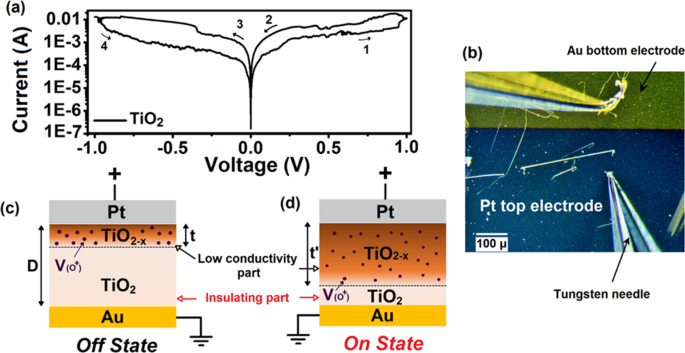
一 Typical logarithmic scale depiction of I–V sweeping graph of Pt/In-doped TiO2/Au memristor. b Device is set off, the metallic cations are distributed in top layer of In-doped TiO2 film. c The formation of filamentary conductive channels, the device is set On (Set, stage 1). d The depletion of metallic cations adjacent to the bottom electrode. The device is set off again (Reset, stage 2). e By imposing the reverse gate voltage, the metallic cations again move toward the cathode electrode (top Pt electrode) and again form a metallic cation bridge and the device is set On (Set-stage 3). f By depletion of metallic cations, at Pt electrode the device is set off again (Reset, stage 4). Reprinted with permission form [174]
The In-doped TiO2 film demonstrated a complementary resistive switching (CRS) behavior during the voltage sweeping between − 1.0 V and + 1.0 V (Fig. 17a) device is set at a higher voltage and again reset at another lower voltage of the same polarity [174]. The cell was set for the first time at V Set1 = 0.732 V and then reset again in the same polarity at V Reset1 = 0.1277 V. In the negative voltage, the second LRS to HRS switching occurred at V Set2 = − 0.7055 V and again reset to HRS at V Reset2 = − 0.0901 V. Thermally assisted charge transfer mechanism is the most possible theory which explain the resistive switching in the ion-doped TiO2 2D film. The unipolar switching confirms the filamentary nature of resistive switching. The filamentary resistive switching is mostly based on the ECM of the mobile ionic species caused by the migration of metallic cations. It facilitates the development of filamentary metal bridges (on state), which can be ruptured later (off state). The filamentary mechanism is the characteristic of this memristor, which is fabricated with electrochemical active electrodes, while the In-doped TiO2 memristor was sandwiched between inert Au and Pt electrodes. It is expected that the switching behavior of In-doped TiO2 device was originated from the migration of both anion and cation components. The versatile switching behavior of In-doped TiO2 device can prove that both anion and cation components are involved in CRS mechanisms. The proposed model suggested that the redistribution of oxygen vacancies and Indium ions inside TiO2 layer can affect, alter and facilitate the RS. In the heterostructured oxide stacks, the conjunction of an oxygen deficient oxide layer (LRS mode) with another oxygen rich layer (HRS mode) triggers the CRS of heterostructured memristor which is caused by the movement of oxygen vacancies. This gradual change of oxygen concentration can trigger occurrence of CRS of memristor due to the difference in resistance of TiO2 stack. From another point of view the formation of filamentary conductive channels assist the RS and increase the conductance of devise. At the initial state or off state (Fig. 17b), the top In-doped layer is in LRS mode while the bottom layer is in HRS. By applying the threshold voltage, the ionic species migrate into lower insulating layer resulting in the formation of conducting filaments and paths (Fig. 17c) and then device reaches to its on state (Set 1). At higher positive voltage, the ionic species in upper layer (mostly In-ions) are depleted (Fig. 17d) and again device will reach to its off state (Reset 2) and demonstrates HRS behavior. The similar phenomenon is expected to occur at the negative biases in which the first on state (Fig. 17e) switches the memristor to new LRS, following another off state after depletion of the ionic species (Fig. 17f). The versatility of CRS behavior of all samples was repeatedly tested several times and the same behavior was observed.
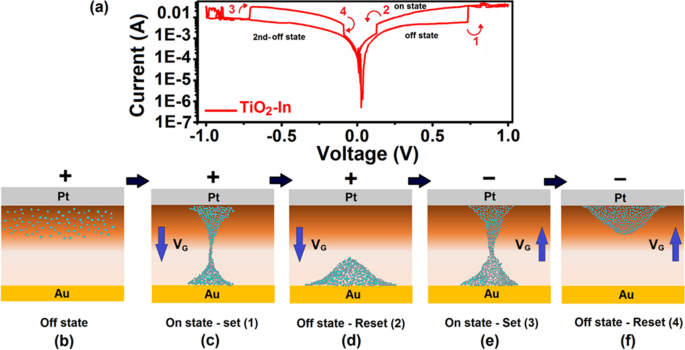
The Pt/TiO2/Ti/Pt stacked crossbar cells:a the SEM top view of (60 nm) 2 cross-point, b The TEM cross-sectional image of 100 nm 2 Pt/TiO2/Ti/Pt device with c its corresponding schematic graph of the plug and disc region in the TiO2 layer. Reprinted with permission from [174]
Artificial Optical Synapses Based on 2D Semiconductors
The human brain operation is highly energy efficient. The data storage and processing are functioned in brain with the lowest possible energy consumption. This ultra-low energy consumption is inspired by the functionalities of biological nervous system. Based on the brain performance, a novel type of computing and processing system was proposed by Alan Turing in 1948, when he introduced the idea of using a computing device with the interconnected network of artificial neurons [175]. It is envisaged that the interconnect network of artificial synapses can effectively solve and overcome the restrictions of the traditional van Neumann computing. The biological synapses, as one of the key members of the neural system, are the information channels ensuring short-term computation, long-term learning and memorization by tuning the synaptic weights [176]. As a biological structure, a chemical synapse is a gapped connection between two neurons through which the communication between two individual axons is created by biochemical reactions. The synapse is a biological junction where the electrochemical waves (action potentials) are transmitted through the axons of neuron. The energy consumption of a biological synaptic event is tangibly lower than that of any other similar device. Analogously, an artificial synapse is a unit which mimics the behavior and performance of the biological synaptic junction to transfer the synaptic signals. From the technical point of view, memristors are the best candidates capable of successful emulation of the characteristics of a biological synapse [177]. The resistive switching mechanism is the basic principle of the memristors. A sandwiched insulator or transition metal oxides between two conductive electrodes is the typical structure of an artificial synaptic device. The synaptic properties are observed in variety of materials with different resistive and synaptic mechanisms. In fact, the diversity of materials with synaptic characteristics experiences a rapid progress, and thus the fundamental understanding of related synaptic mechanisms is currently progressing. Metal oxide resistive random access memories (RRAMs) (such as TiO2, AlOx , HfOx , WOx , TaOx ), conductive bridge synapses (Ag- and Cu-based electrodes), phase-change material-based synapses (PC synapse), ferroelectric material-based synapses, magnetoresistive (MR)-based synapses, carbon nanotube based synapses, and organic nanostructured-based synapses are some of the active memristor materials that demonstrated attractive synaptic characteristics [177]. The optical stimulated synaptic devices are recently introduced into telecommunication technology. In optical synapses, optical pulses of light stimulate the generation of charge carriers between two conductive electrodes. The photogenerated charge carriers in atomically thin 2D MoS2 film allow the modulation of the synaptic weights with photonic pulses. This optical capability of artificial synapse is highly important that capitalizes the possibility of high-bandwidth optical communication protocols. The schematic of 2D MoS2-based synaptic unit is depicted in Fig. 18a [178]. As the main privilege, the incorporation of the optical and electrical pulses addressed the different charge trapping mechanisms to precisely modulate the synaptic weights. Furthermore, the instrument was capable of neuromodulation to achieve the plasticity and metaplasticity properties via dynamic control of spike-time-dependent plasticity (Hebbian theory). The schematic of analogue circuit is demonstrated in Fig. 18b depicting the interplay between Hebbian and homeostatic plasticity. The interplay between Hebbian and homeostatic synaptic plasticity in MoS2 synapse is provided in Fig. 18c–e, respectively. The long-term potentiation strength was achieved by employment of sequential voltaic training pulses in synaptic instrument. It was observed that the synaptic weights increase linearly by increasing the number of training pulses. It was also demonstrated that the application of 100 training pulses resulted in the weight change of synapse up to 117% in electronic mode, while the same number of training pulses in ionotronic-mode resulted in the increase of weight up to 223%. (Fig. 18c, d) [178]. In the optically stimulated synaptic unit, a strong long-term potentiation was observed in the 2D MoS2 artificial synapse via using the optical gating function (Photoactive mode). The light pulses (λ = 445 nm) played the role of presynaptic signals. Up on the illumination on the surface of 2D MoS2 synapse, the conductance increased rapidly and then continued until the gradual saturation when the conductance was one order of magnitude above the value of dark-current. A rapid drop of conductance occurred on the termination of optical illumination source, but the conductance still remained in high values (Fig. 18e). The band-to-band transition is expected to be the main reason for rapid transition, while the long-lasting high conductance values in optoelectronic mode were attributed to the defect or trap-centred slow recombination of generated electron/holes. The observations are in accordance with the proposed model of random local potential fluctuation (RLFP). This state is called persistent conductivity [178]. By the increase of optical pulses and higher number of photons, the decay time became slower. This is consistent with the RLPF model where higher carrier numbers occupy sites of the local potential minima, and therefore, the rate of election/hole recombination would be slower. The vivid manifestation of this phenomenon is slower degradation of photogenerated current in synaptic device.
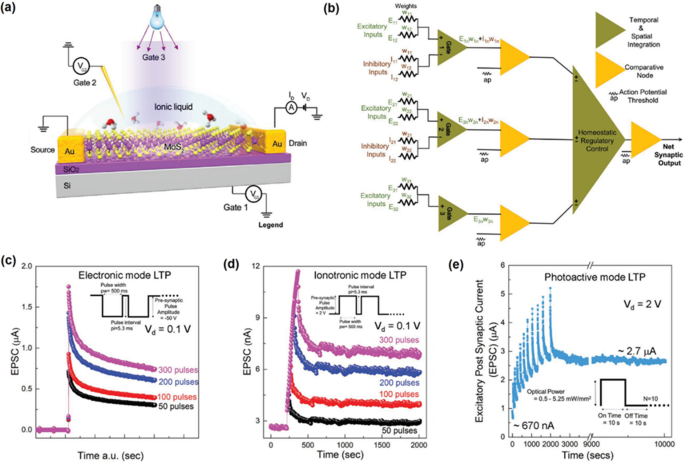
Graphical scheme of triple modulated architecture of artificial 2D MoS2 synaptic device. b The analogue circuit depicting the interplay between the various parameters for stimulation of synaptic plasticity. c The interplay between the Hebbian and synaptic plasticity in MoS2-based 2D synaptic device, which depicts the enhancement in the strength of long-term potentiation functionalities of device as he function of training by electronic-mode, d Ionotronic mode and e photovoltaic mode. In photovoltaic mode, the light intensity is altered (from 0.5 to 5.25 mW mm −2 ) to enable training by optical pulses. Reprinted and reproduced with permission from [178]
Two-terminal optical synapse based on In-doped TiO2 ultra-thin film was also fabricated for emulation of the synaptic functionalities [174]. The In ions were doped into ~7.0-nm-thick TiO2 film deposited by ALD technique. It was observed that the ion doping affected the RS mechanism and also extended the optical absorption edge of ultra-thin 2D TiO2 film to the visible light range. It was measured that the set voltage of the TiO2-based synaptic device was shifted to the lower voltages after optical stimulation of In-doped TiO2 memristor. These observations (Fig. 19a) confirmed the impact of photogenerated electron/hole on occupation of trapping sites in amorphous TiO2 film and consequently resulted in the decrease of the set voltage (Fig. 19b) and the increase of memristors’ conductance (Fig. 19b). Furthermore, the increase in light intensity slightly affected the set voltage of memristors, which is an indication of saturation state in the number of photogenerated charge carriers. Therefore, it does not let the device to achieve the lower V Set values. The emulation of optical synaptic characteristics was verified by the observation of unrested postsynaptic current caused by singular optical pulse (Fig. 19c). PPF synapse values were demonstrated by two consecutive EPSC spikes with pulse intervals of 0.3 s (Fig. 19d). The rapid decay of PPF index of device [the ratio of amplitude of the 2nd EPSC (A2) to the 1st EPSC (A1)] was discovered after the increase of pulse intervals. It shows the sensitivity of short-term plasticity of optical synapses to the sequence of optical pulses (Fig. 19e). The calculated energy consumption of In-doped TiO2 optical synaptic device for a singular pulse was estimated to be around 2.41 pJ (pulsed optical signal with 10 ms duration) (Fig. 19e). It was observed that the energy consumption of In-doped ultra-thin TiO2 optical synapse was highly efficient [174]. Moreover, when the successive laser pulses with different frequencies were employed, transition from STP to LTP emulated by the same optical synaptic unit (Fig. 19f). These results clearly demonstrated that the optical stimuli with the lower pulse intervals are beneficial for facilitation the LTP capabilities. Observations also confirmed that shorter pulse intervals resulted in higher gain values consistent with the effect of residual generated carries on the following pulses [174]. The EPSC and conductance saturation were also detected and observed during the study of synaptic behavior of artificial synapses. This phenomenon was attributed to the saturation of photogenerated electron/holes. It was also shown that the instrument was capable of emulation of bidirectional analogue switching.
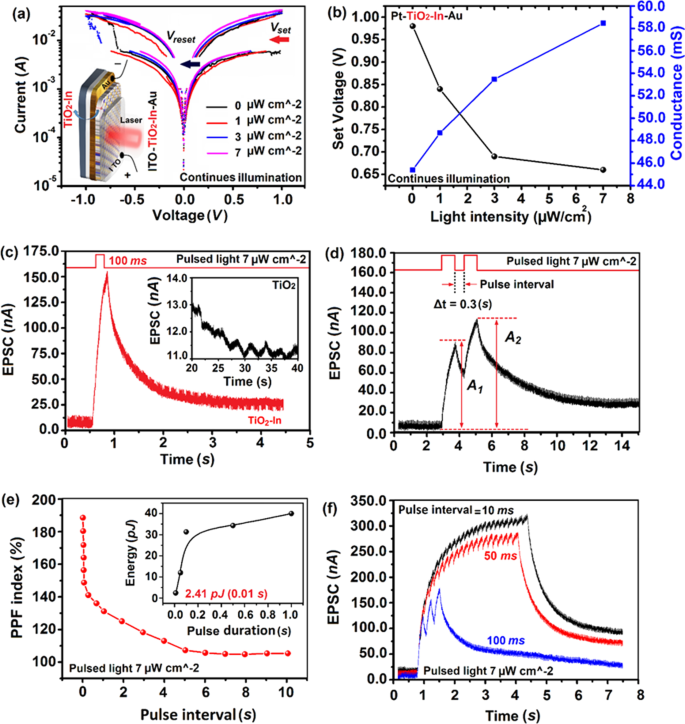
The optical synaptic characteristics of In-doped ultra-thin TiO2 films. 一 The logarithmic scale I–V curves of ITO/In-doped/Au synaptic device. Variation of the set voltage and conductance vs changes of light intensity for pulsed lasers. c The EPSC of synaptic device induced by 7 μW cm −2 laser pulse. d The PPF of device. e The variation of PPF index vs. the pulse intervals. Inset shows the variation of energy consumption vs. pulse duration. f The variation of EPSC of synaptic device stimulated with the pulsed light with different pulse intervals. Reprinted with permission from [174]
Artificial Optical Nociceptors Based on 2D Semiconductors
Mimicking the human brain functionalities by using neuromorphic-based technologies is quite essential achievement towards the development of the artificially engineered bio-inspired electronic instruments [52]. The emulation of human sensory system and the sensorimotor functionalities are significant hurdles in biomimetic studies. Visual processing is fulfilled by outstanding features of the human’s eye (Fig. 20a) [52]. Eye, as the natural visual detector and processor consists of a large number of receptors and nociceptors (Fig. 20b–d). In fact, nociceptor is a key sensory receptor that recognizes noxious stimuli, which in turn generates and delivers the warning signals to the central nervous system. The cornea has the highest number of nociceptors in the human eye and the majority of the corneal nociceptors are polymodal. Looking at the nervous system, the biological synapse is the fundamental base of sensorimotor system facilitating various functionalities including the pain signal transfer in the neural system (Fig. 20e). The analogous artificial nociceptive device with similar synaptic functionalities is composed of a semiconductor ultra-thin film sandwiched between two conductive layers (Fig. 20f).
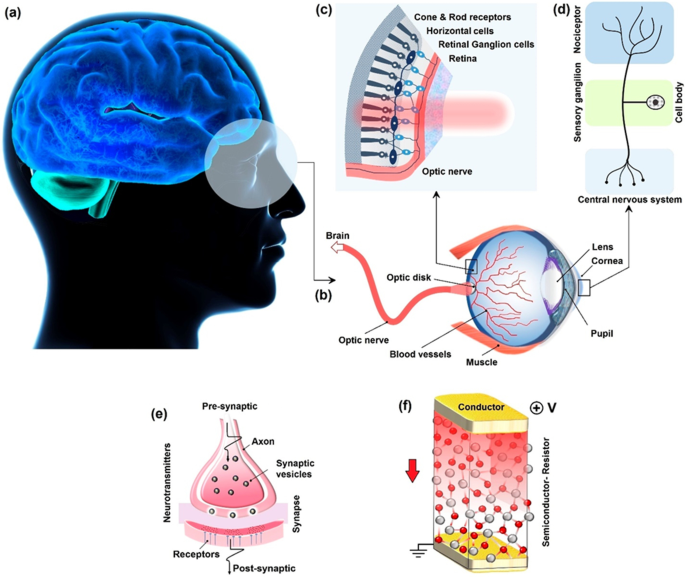
Scheme of human eye receptor and nociceptor system. 一 The human brain as decision making unit receives the informative signals from b human eye and its sensory components including the c light receptors and nociceptors in Retina section. d Shows a typical nociceptor with its components. e Is the typical schematic representation of a natural synapse and f its artificial counterparts in conductor/ semiconductor /conductor sandwiched configuration. Reprinted with permission from [52]
Optical artificial nociceptors built upon ultra-thin amorphous all-oxide heterostructures with ionic transport, anisotropic electrical characteristics and ultimate transparency. A heterostructured 2D Ga2O3/TiO2 film was fabricated to make an optical nociceptor device [179]. To alter the heterointerfaces between Au electrodes and TiO2 optical semiconductor films, the Ga2O3 2D film was annealed in N2 atmosphere. The successful incorporation of N2 atoms into ultra-thin Ga2O3 film was accompanied by phase transformation of Ga2O3 into more conductive phase. Raman spectroscopy measurements showed the characteristic peak of Ga-N bonding after annealing process in N2 atmosphere [179]. The Ga2O3 film was still in high level of transparency (up to 90%) [179]. From the PL spectra, it is found that the bandgap of 2D WO3 is around 2.88 eV. The PL spectra also showed notable modification of bandgap after RTA of Ga2O3 2D film in N2 atmosphere. The bandgap of 5-nm-thick Ga2O3 film was shifted from 4.1 eV to 3.46 eV for N2 doped Ga2O3 film. It was observed that the oxygen vacancies were replaced by atomic nitrogen in the Ga2O3 nanostructure. The heterointerface engineering of 2D Ga2O3 (N2)/TiO2 altered the resistive switching mechanism of 2D heterostructured memristor film [179]. A self-rectifying behavior was observed during the measurement of optical resistive behavior of heterostructured films. The studies show how the N2 incorporation has considerably altered the energy band alignment at the Ga2O3/TiO2 hetero-interfaces [179]. Thus, the charge transfer mechanisms at Ga2O3:TiO2 and Ga2O3 (N2)/TiO2 hetero-interfaces are expected to be different. A bipolar resistive switching performance was observed during I–V cyclic test of Au/Ga2O3–TiO2/ITO device under the visible light illumination. The tunable HRS/LRS ratio and loop opening characteristics are the main privileges of Au/Ga2O3/TiO2/ITO optical memristor under the visible light illumination. The Ga2O3 (N2-600 °C)/TiO2 heterostructured device has experienced strong rectification behavior which is a characteristic of the development of type-II heterointerface [52, 179, 180]. Thus the main characteristic of this device is its nanoscale ultra-low memristive current, which shows the capability of this unit for the fabrication of the self-rectifying resistive switching-based instruments with low-energy consumption. The nociceptive behavior was observed during the study of reaction of Au–Ga2O3/TiO2–ITO and Au–Ga2O3 (N2-600 °C)/TiO2-ITO. The ignition time (t 0) and saturation time (t s) of the Ga2O3 (N2)/TiO2-based nociceptors are shown in Fig. 21a [179]. The relaxation phenomenon is another characteristic of nociceptors, which was observed in the Ga2O3 (N2)/TiO2-based heterostructures (Fig. 21b). After the nociceptor ignition the ultimate time for the retrieval of nociceptor to off state is called relaxation time. This behavior is similar to the non-adaptation characteristics of the human nociceptors, when the generated warning signals protects the human organs from further unnecessary exposure to hazardous stimuli [180, 181]. It was also found that the relaxation time is the function of the frequency of pulsed light. The abnormal state is a condition when a nociceptor component experiences stimulating signals which are stronger than its natural threshold. In the abnormal state the nociceptor performs similar to the receptor system. Figure 21c shows the difference between the optoresponsive reaction of an abnormal and normal nociceptor. It depicts how the damaged nociceptors show reaction to the constant visible light. The allodynia and hyperalgesia are the individual characteristics of damaged nociceptor in te abnormal state. The response of nociceptor is continuously increased and the device did not follow the non-adaptation mode when the light intensity is increased (Fig. 21d) after 5 min illumination, which is the characteristic behavior of nociceptors in the abnormal state [179]. Generally, it was found that the nanoengineering and functionalization of semiconductor hetero-interfaces facilitated the fabrication of smart bio-inspired photoreceptors and nociceptor gadgets with self-adapting characteristics.
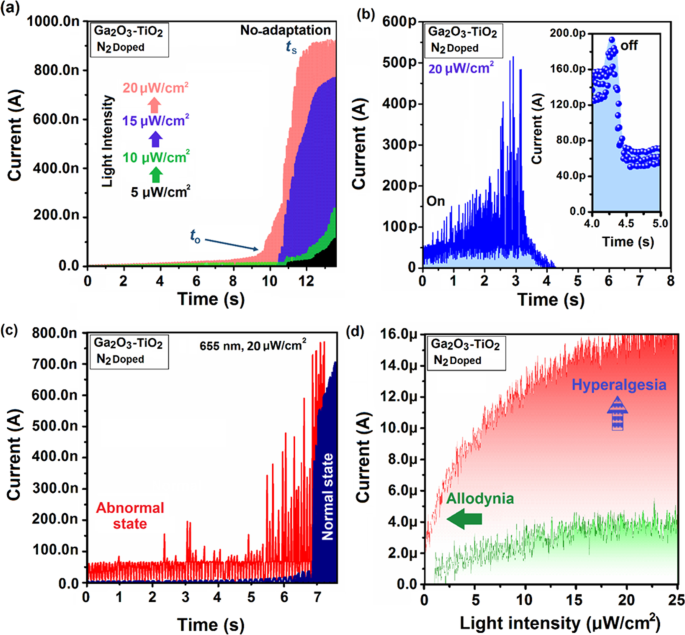
一 The photoinduced nociceptive behavior of Ga2O3 (N2)/TiO2-based heterostructured devices. The effect of light intensity (λ = 655 nm) on threshold time (t 0) and saturation time (t s) of Ga2O3 (N2)/TiO2 nociceptor. The light frequency was 20 Hz. b The relaxation characteristics of Au- Ga2O3 (N2)/TiO2-ITO nociceptor. The light frequency was 20 Hz. c The distinction of photoresponse behavior of Au-Ga2O3 (N2)/TiO2-ITO nociceptor in normal and abnormal state. The light frequency was 20 Hz. d The allodynia and hyperalgesia behavior of Au-Ga2O3 (N2)/TiO2-ITO opto-nociceptor. Reprinted with permission from [179]
Conclusions
The present review has outlined the most recent advancements in the development of wafer-scaled 2D semiconductor nanomaterials for the practical devices fabricated by CVD and ALD techniques. Each of these techniques has its own unique features, merits, complexity, architectures and attractiveness. Despite the rapid progress in the deposition techniques of 2D materials it is fair to say that this field still is in progressing stage. Absolutely new functional opportunities can be initiated and launched if the next generation of advanced functional instruments will be based on 2D semiconductors. Specifically, the outstanding performance of these devices can be achieved through the combinatorial multi-stacking layered 2D nanomaterials. Considering that each of 2D materials has quite different functionalities, multi-functional nanomaterials can be created with enormous advantages in terms of energy and volume. It can be envisaged that a library of 2D materials and nanosheets is required to be updated and renewed regularly. Furthermore, the library of 2D materials is required to be extended by using innovative methods for synthesis of 2D materials from novel material sources.
Moreover, some of the drawbacks of 2D materials fabrication mentioned in review can be solved by obtaining further knowledge about nanointerfaces formation. In this case, the nucleation step and the epitaxial growth has to be controlled in order to avoid or tune eventual interface layer and defects at the interface as well as the mechanical stress and the lattice deformation that can occur in vdW heterostructures. Such stacking imperfections have drastic effects on the physical properties, and therefore, must be addressed for implementation of the final structures. Moreover, the relative rotation angle between both layers directly influences the elastic deformations and hence their tuning permits tailoring the electronic properties of the whole structure. In this regard controlling stack orientation of the ALD fabricated 2D heterostructures would allow the fabrication of 2D materials that have not yet been explored and stipulate new pathways for 2D electronic device fabrication, such as FETs, memristors, resistive switching memory cells and microelectromechanical systems. To enable controlled growth of successive ALD 2D layers, surface functionalization (chemical or physical ) might be required. Despite eventual vdW induced growth, lack of dangling bonds on the 2D surface may inhibit the subsequent deposition. Consequently, the specific functionalization could be realized in order to allow the ALD nucleation while preserving the intrinsic properties of the underlying material.
For further progress in ALD fabrication of various 2D semiconductors, novel ALD precursors must be developed allowing broader expansion of ALD technique in the field of 2D nanomaterials. In this regard, several predicted 2D materials, as silicene, germanene, phosphorene, as well as telluride have not yet been ALD fabricated owing to the lack of suitable precursors. It should also be pointed out that even though graphene is the most studied 2D material, its ALD is still challenging, the only ALD process available leading to material quality inferior to the one obtained using CVD technique.
Finally, one of the main challenges highlighted in many recent published reports is the transition of 2D nanomaterials and their heterostructures into various industrial applications. Currently, only CVD produced graphene is under such transition. Thus, one can envisage that progresses of ALD and CVD of 2D nanomaterials, in particular direct growth of the wafer scale without grain boundaries on integrable devices, will enable their fast industrialization and comercialization.
数据和材料的可用性
不适用。
缩写
- ALD:
-
原子层沉积
- CVD:
-
化学气相沉积
- SEM:
-
扫描电镜
- EDS:
-
能量色散光谱
- XPS:
-
X射线光电子能谱
- UV–vis:
-
紫外可见
- FTIR:
-
Fourier Transform Infrared
- PL:
-
光致发光
- TMDC:
-
Transitional metal dichalcogenides
- vdW:
-
Van der Waals
- COFs:
-
Covalent organic frameworks
- FET:
-
场效应晶体管
- HRTEM:
-
高分辨透射电子显微镜
- VCM:
-
Valence change memristor
- ECM:
-
Electrochemical metallization memories
- CRS:
-
Complementary resistive switching
- MR:
-
Magnetoresistive
- RLFP:
-
Random local potential fluctuation
纳米材料


